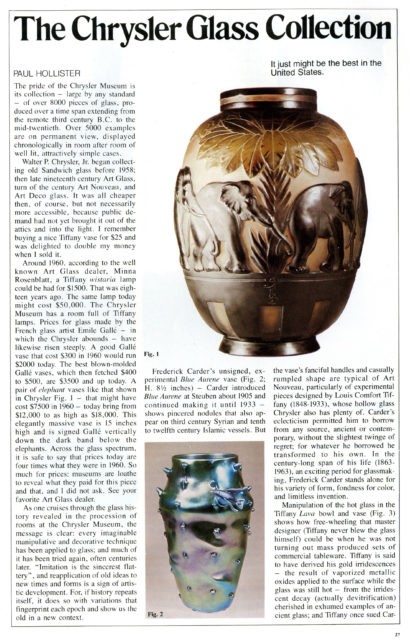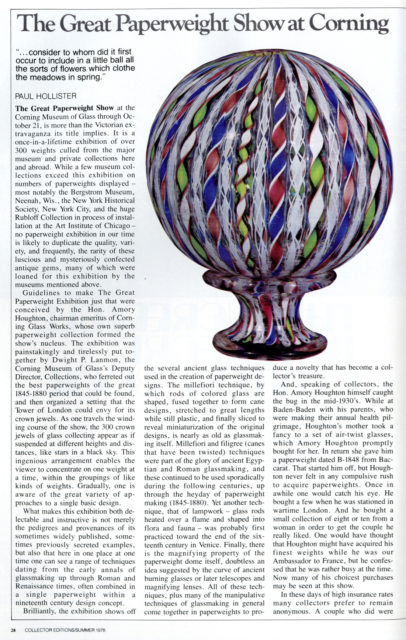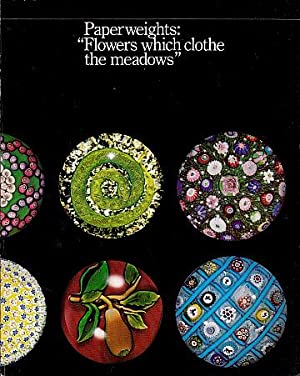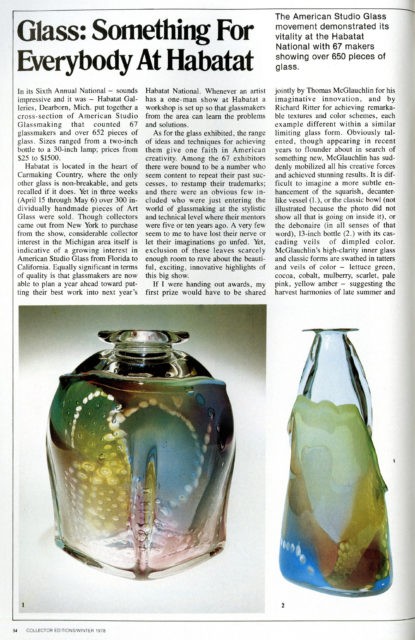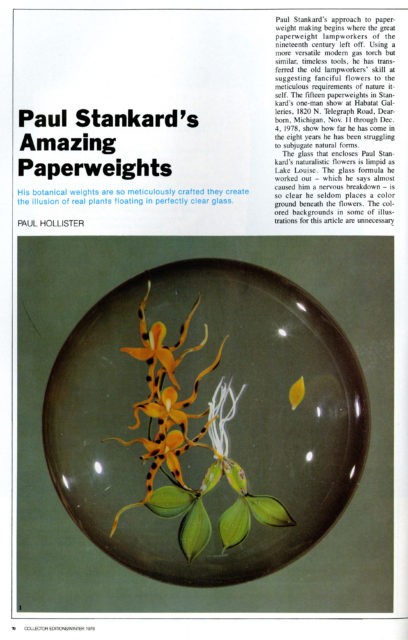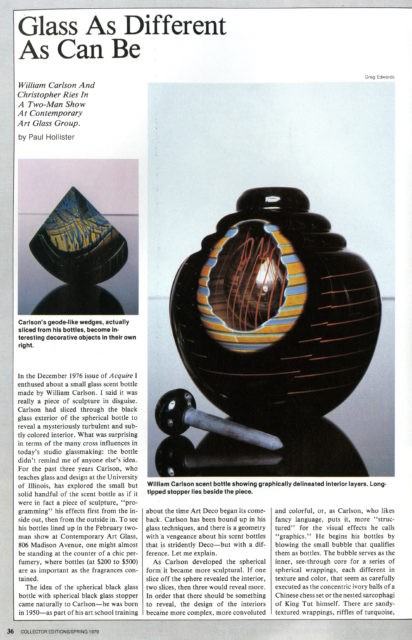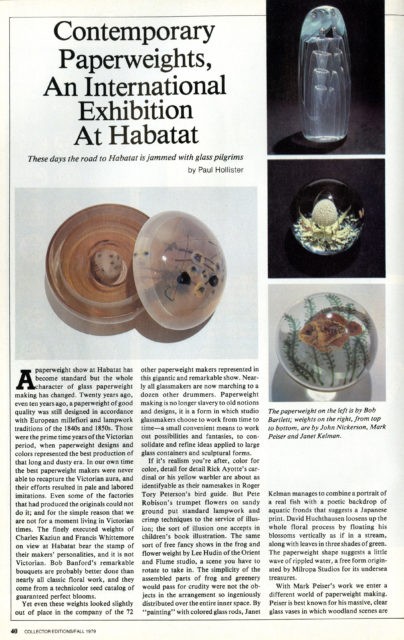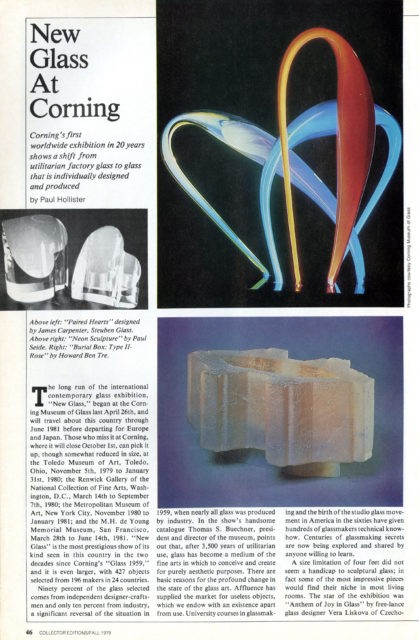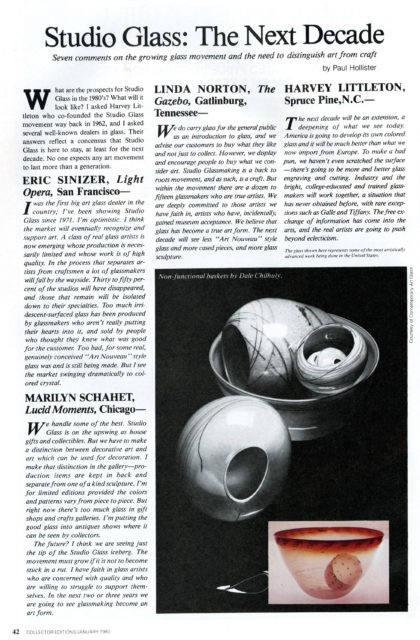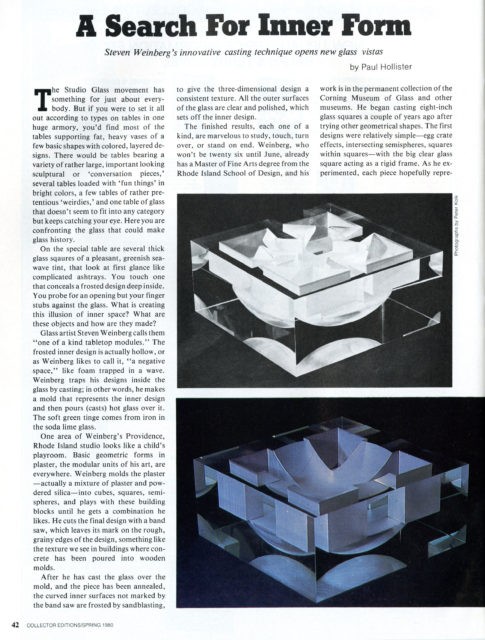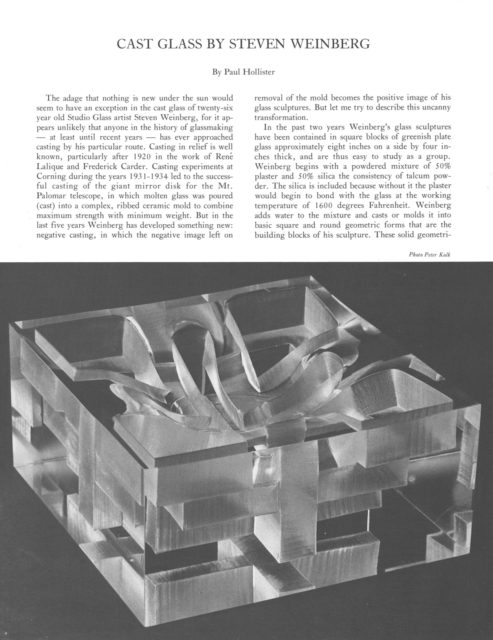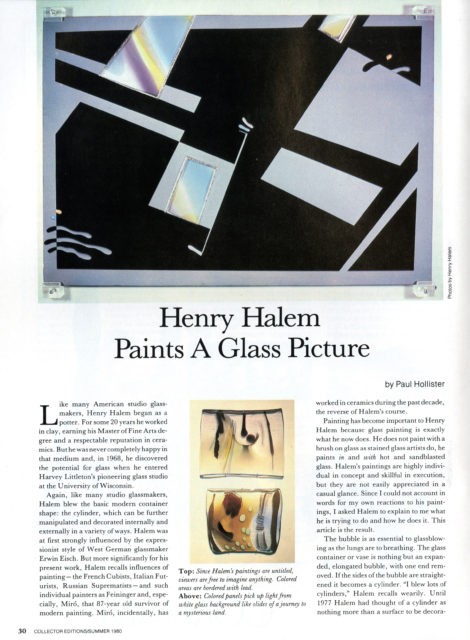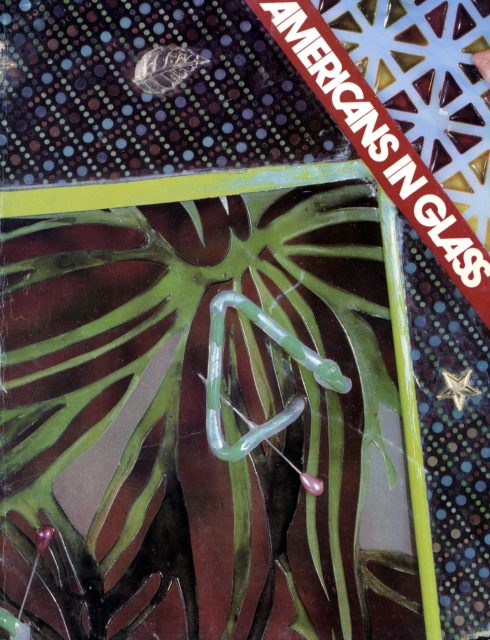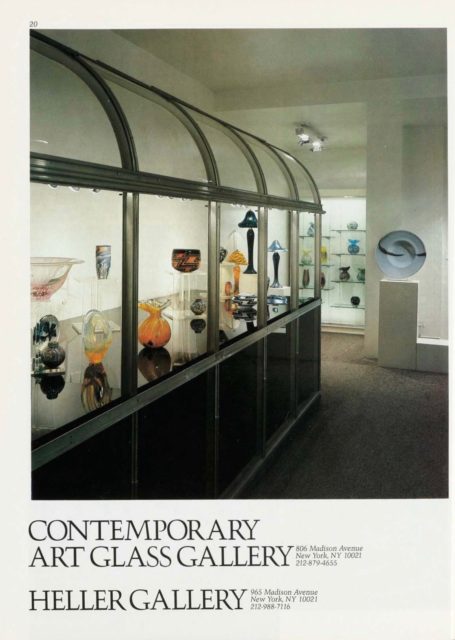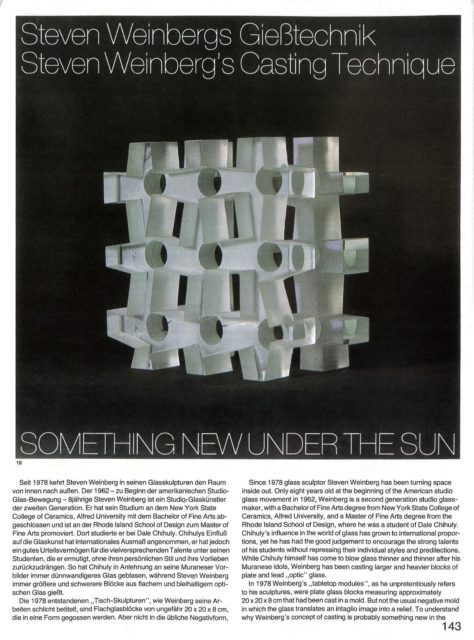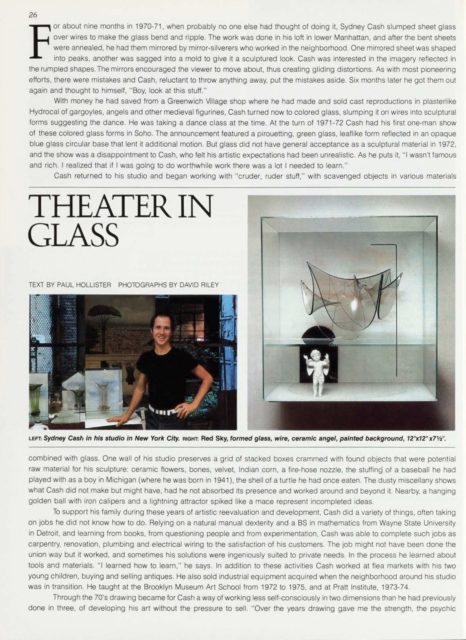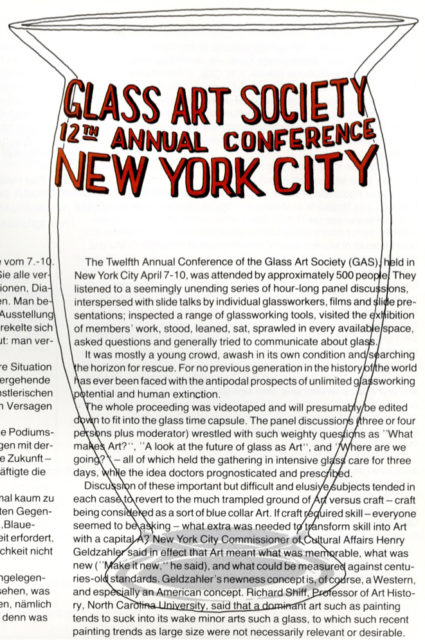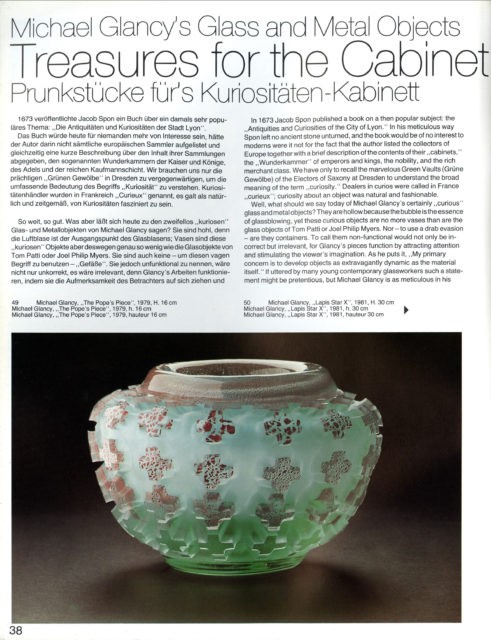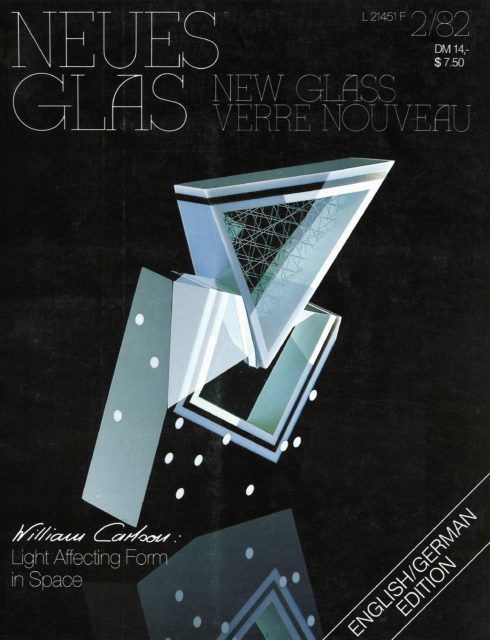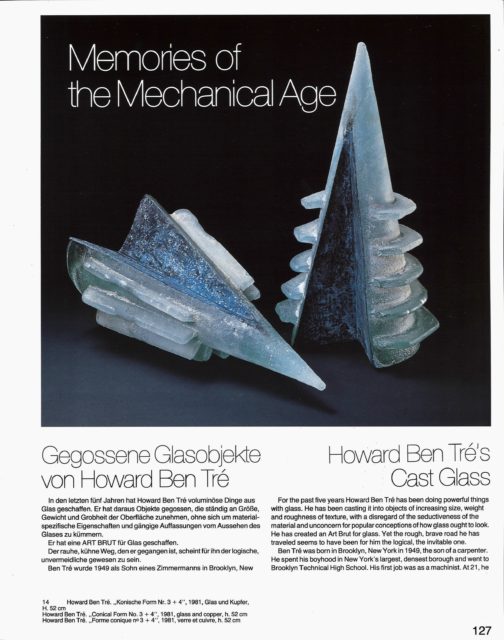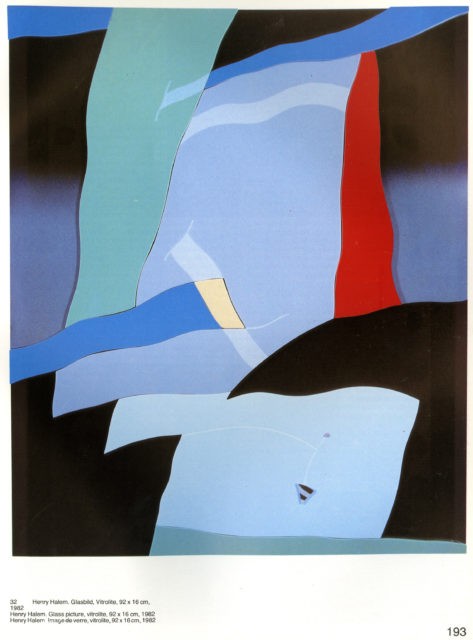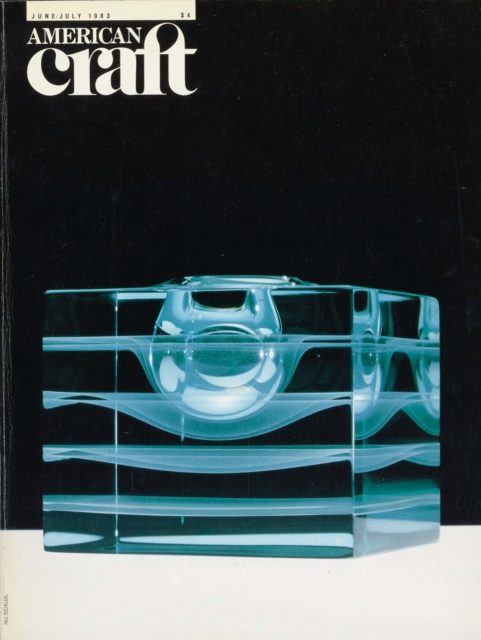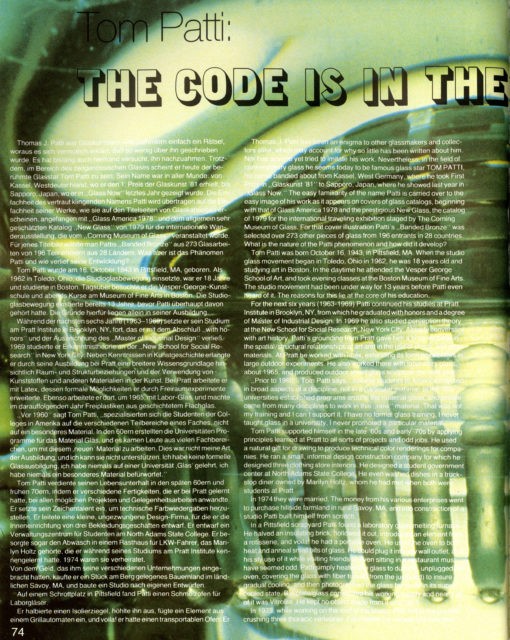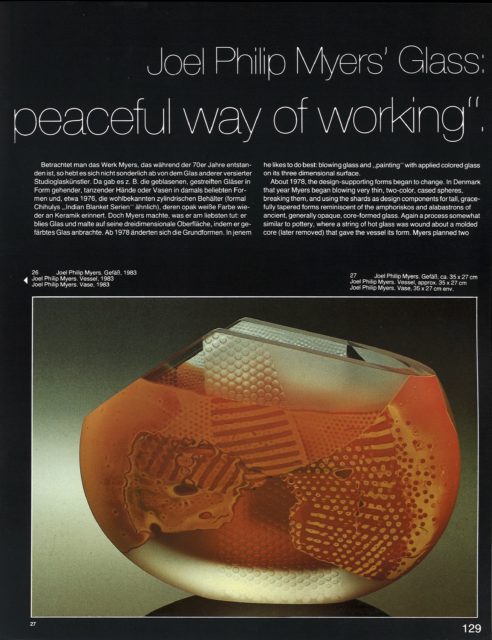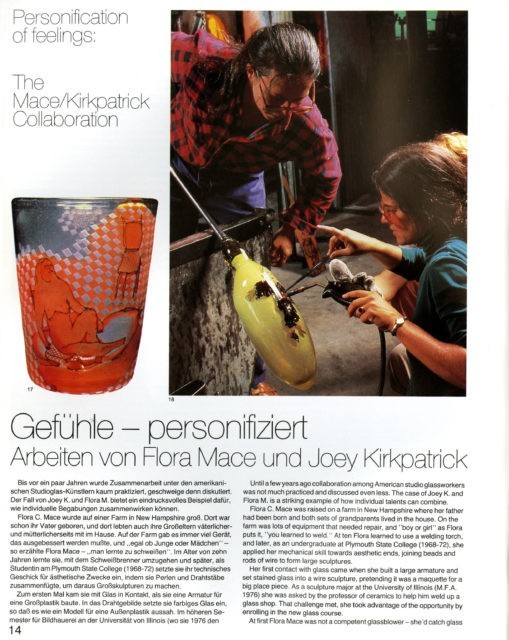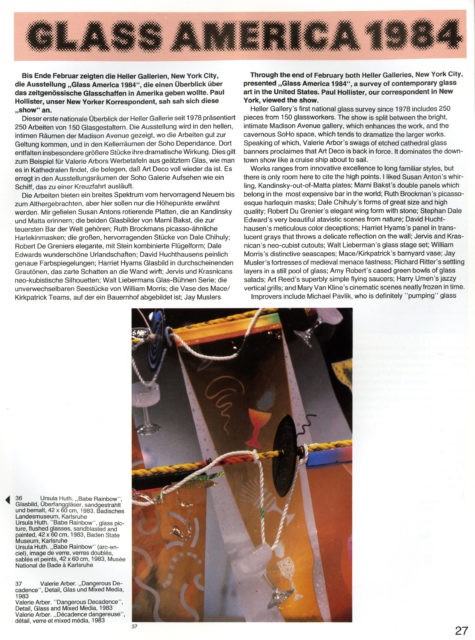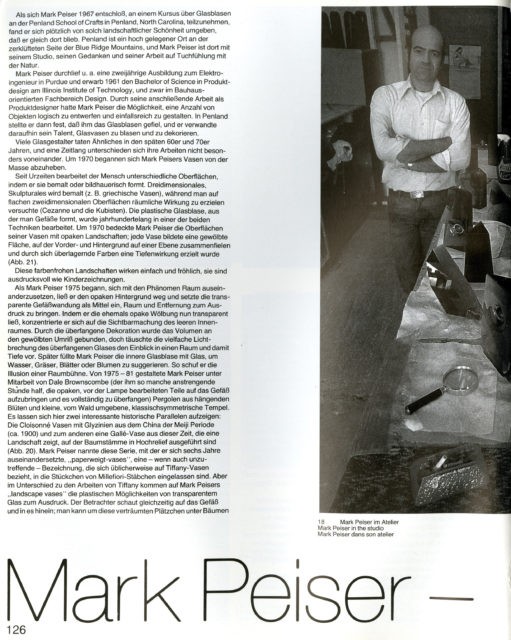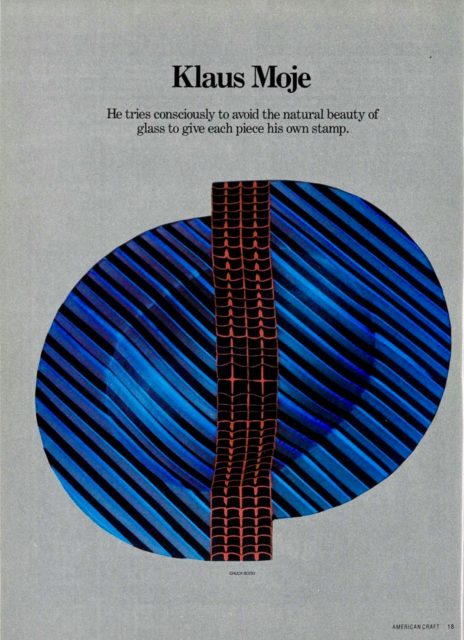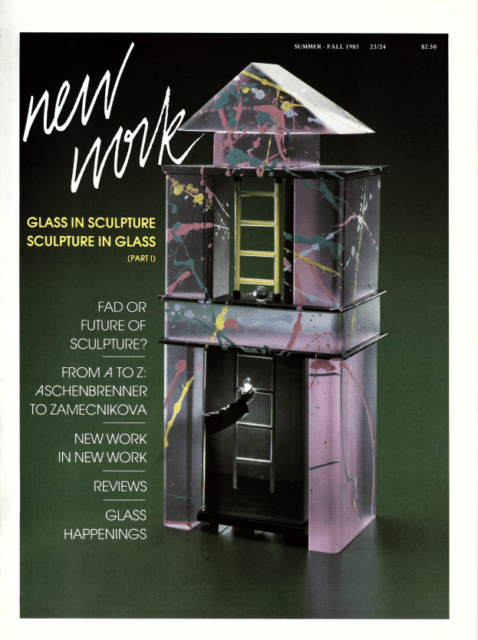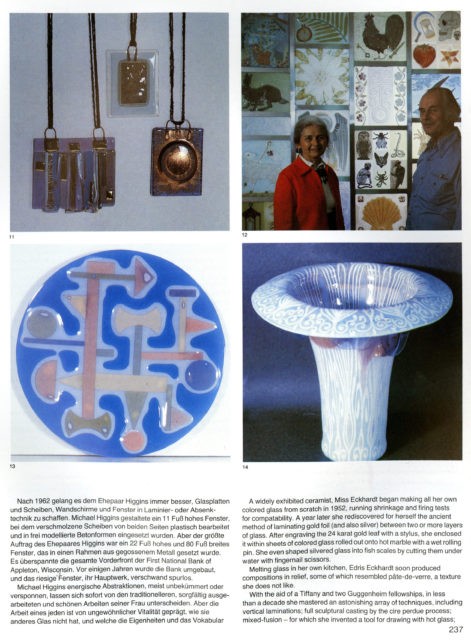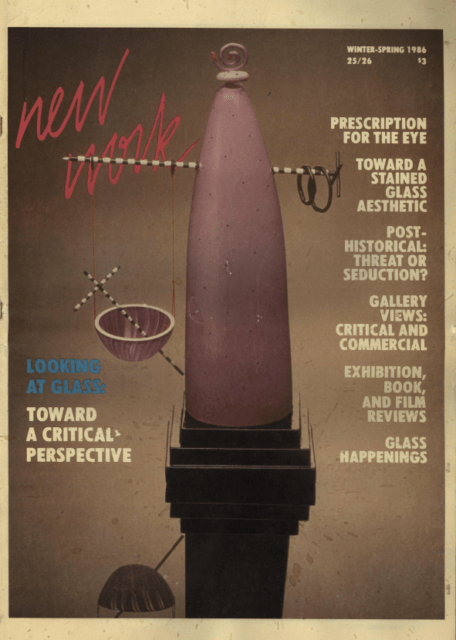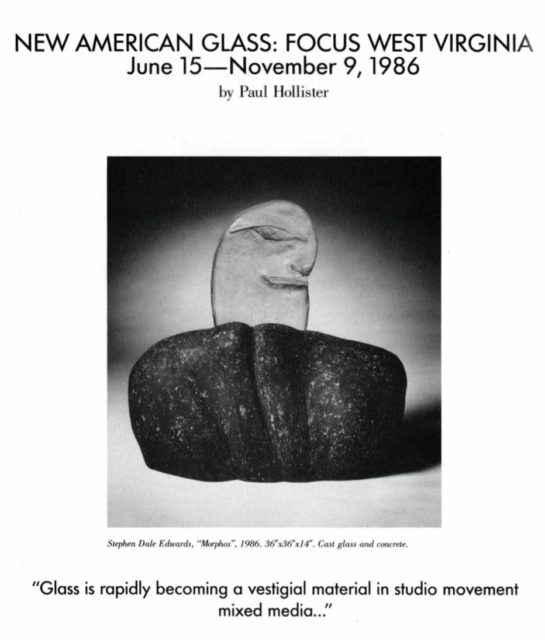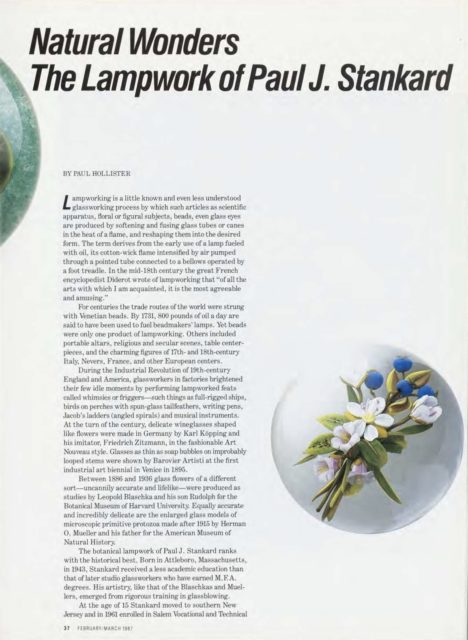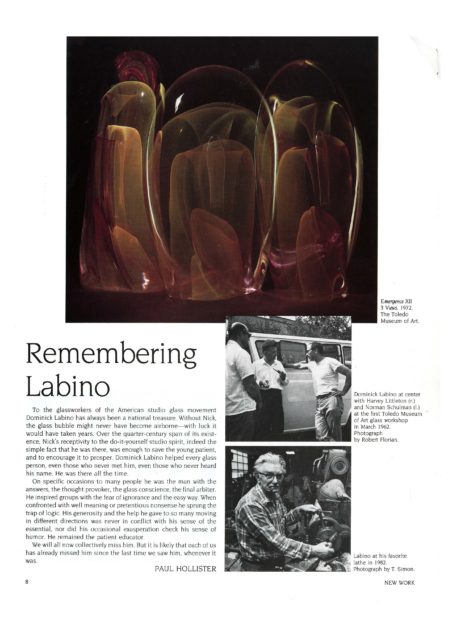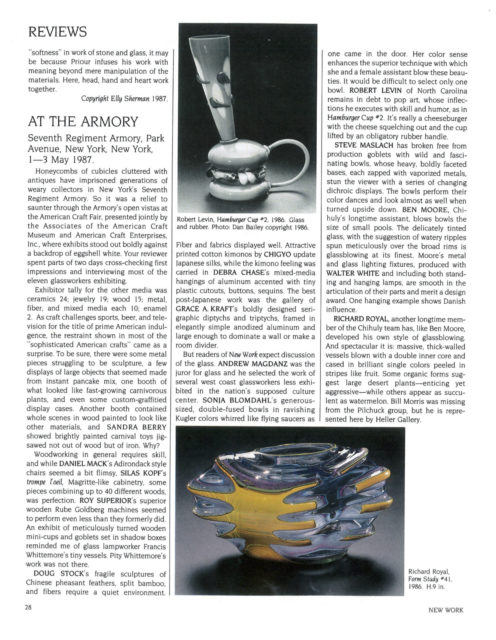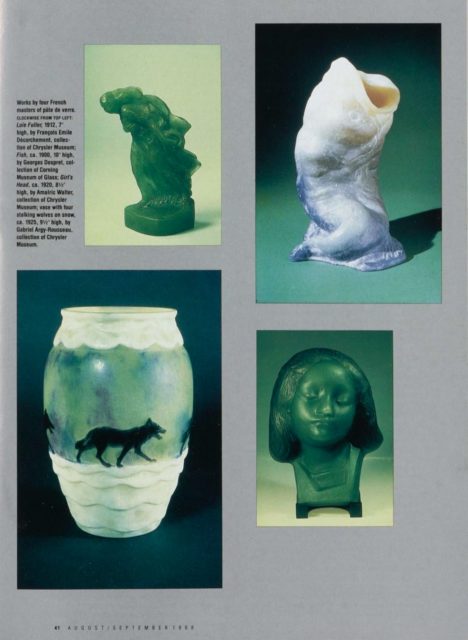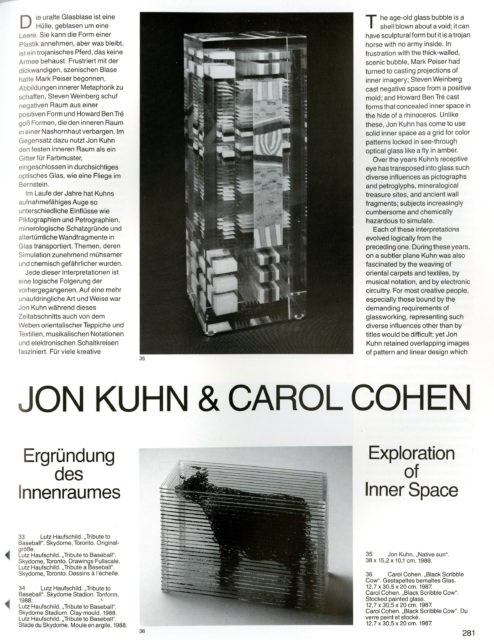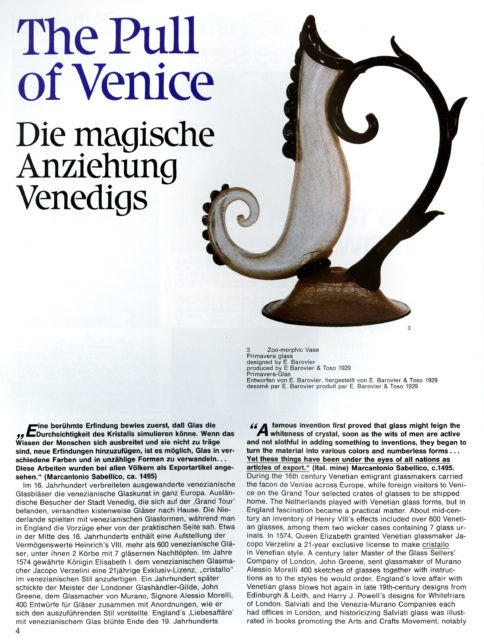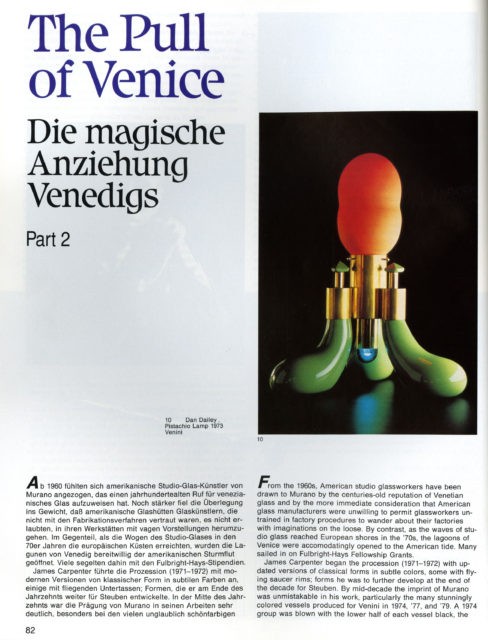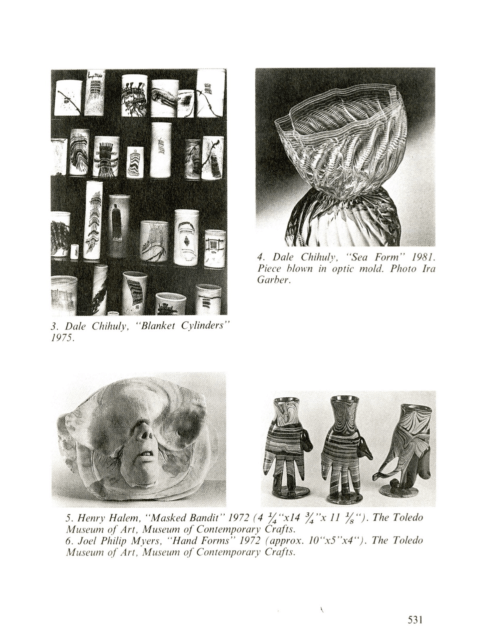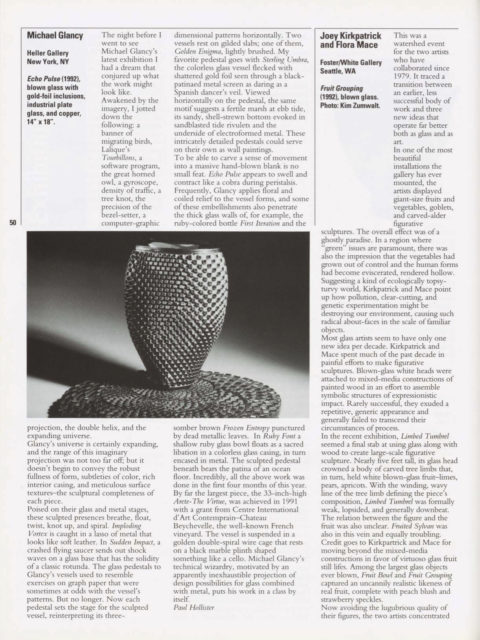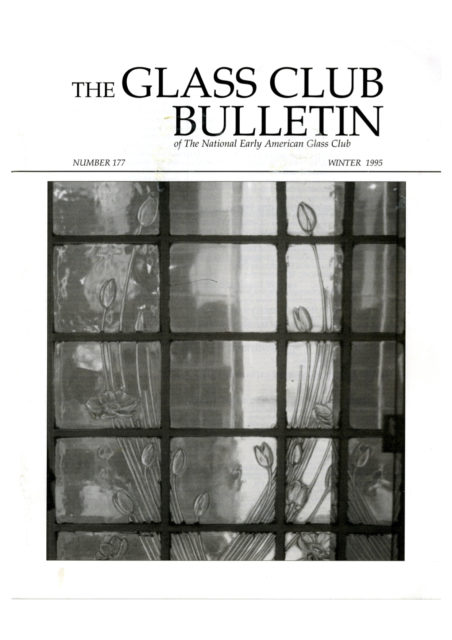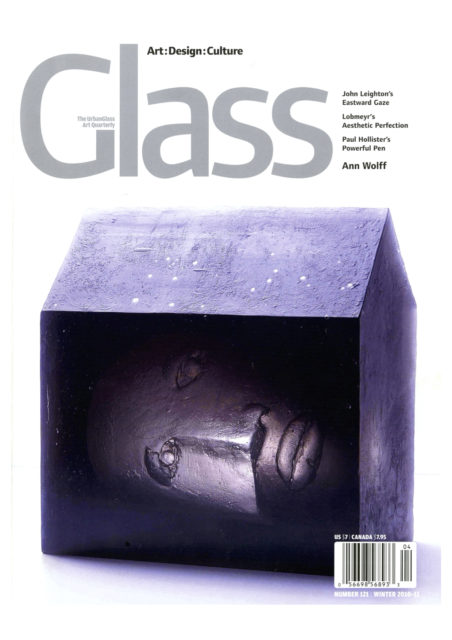Annotated Bibliography
Compiled by Catherine Whalen and Irene Hollister; annotated by Catherine Whalen, Susie Silbert, and Colleen Terrell.
This comprehensive annotated bibliography brings together Paul Hollister’s critical writings on studio glass, published between 1976 and 1995. The majority appeared in periodicals: the New York Times, Neues Glas, Collector Editions (previously Acquire), American Craft, Glass (previously New Work), The Glass Club Bulletin, Glass Art Society Journal, and Ontario Craft. Hollister also contributed to the exhibition catalogues Paperweights: “Flowers which clothe the meadows”, Americans in Glass, and New American Glass: Focus 2 West Virginia; the anthology Glass State of the Art 1984; and Annales du 11e Congrès de l’Association Internationale pour l’Histoire du Verre. Rounding out the 90 entries are articles about Paul Hollister and Irene Hollister, published in the Journal of Glass Studies, Glass, and Paperweight News.
Each entry features a link to a downloadable PDF or online source for that writing, a list of people and places mentioned, and links to pertinent pages on this site. Several entries reference relevant interviews and lectures that Paul Hollister recorded for research purposes. See linked names for Bard Graduate Center transcripts of these audio recordings, which are held by The Rakow Research Library of The Corning Museum of Glass.
Jump to 19751975
“Hollister on Glass.” Acquire 4, no. 5 (December 1976): 26-27. Editor’s note: Acquire subsequently renamed Collector Editions.
“Hollister on Glass.” Acquire 4, no. 5 (December 1976): 26-27. Editor’s note: Acquire subsequently renamed Collector Editions.
Hollister briefly describes the emergence, following the 1962 glass workshop led by Harvey Littleton and Dominick Labino at the Toledo Museum of Art, of a new movement of “art” or “studio” glass in America. The work of a younger generation of individual “glass artist-producers” was gaining acceptance, exhibition exposure, and interest from museums and collectors. Hollister details and assesses an assortment of vases and bottles—some verging on “piece[s] of sculpture in traditional disguise”—by seven artists and two glass studios, all of which can be found at Contemporary Art Glass Group in New York City. He particularly admires work by James Daniel, William Carlson, and Tom Patti and predicts that a small laminated vase by Patti will be repeatedly illustrated in contemporary-glass publications. Incl. prices and illus. (5 b/w, 5 color) of work by Michael Boylen, William Carlson, Joseph Clearman, James Daniel, David Donaldson, Lynn Kirschbaum, Charles Lotton, Lundberg Studios, Tom Patti, and Mark Peiser.
Michael Boylen, William Carlson, Joseph Clearman, Contemporary Art Glass Group [later Heller Gallery], James Daniel, David Donaldson, Lynn Kirschbaum, Dominick Labino, Harvey Littleton, Charles Lotton, Lundberg Studios, Tom Patti, Mark Peiser, Tiffany, Toledo Museum of Art
“The Chrysler Glass Collection.” Collector Editions 6, no. 2 (Spring 1978): pp. 27-29.
“The Chrysler Glass Collection.” Collector Editions 6, no. 2 (Spring 1978): pp. 27-29.
Hollister provides a brief overview of the scope, layout, and installation of the Chrysler Museum’s 8,000-piece encyclopedic glass collection (5,000 works on view) initiated by a gift from Walter P. Chrysler, Jr. Hollister outlines the arc of Chrysler’s glass collecting with an emphasis on the current desirability of his acquisitions of late nineteenth- and early twentieth-century glass. Work by masters of this era including Frederick Carder, Auguste Daum, Émile Gallé, René Lalique, Gabriel Argy-Rousseau, and Louis C. Tiffany—whom Hollister identifies for their ability to adapt historical precedent in service of an individualized artistic view—dominate the text. The article concludes with a barb aimed at contemporary glassworkers rehashing these older styles: “The Art Brand-Nouveau of today is a pale, stale apeing of what was once crammed with imagination and technical knowhow that characterizes the real thing.” Incl. prices and illus. (7 b/w, 6 color) of work by Gabriel Argy-Rousseau, Frederick Carder, Auguste Daum, Émile Gallé, and Louis C. Tiffany.
Argy-Rousseau, Frederick Carder, Walter P. Chrysler, Jr., Chrysler Museum, Gustave Courbet, Daum, Lalique, Gallé, George Innes, Minna Rosenblatt, Steuben, Tiffany
“The Great Paperweight Show at Corning.” Collector Editions 6, no. 3 (Summer 1978): pp. 28-29.
“The Great Paperweight Show at Corning.” Collector Editions 6, no. 3 (Summer 1978): pp. 28-29.
The review of The Great Paperweight Show at The Corning Museum of Glass (April 29–October 21) deems it a jewellike “once-in-a-lifetime exhibition.” It features 300+ weights drawn from museum and private collections, notably that of Armory Houghton, chairman emeritus of Corning Glass Works. Hollister admires the museum’s scholarly approach and the show’s dramatic and instructive installation, including attention to weights whose makers incorporated “ancient glass techniques” in their designs. Dwight P. Lanmon, Corning’s deputy director of collections, and Hollister both selected weights for the exhibition and coauthored its catalogue. Hollister begins his review with the quotation, “Consider to whom did it first occur to include in a little ball all the sorts of flowers which clothe the meadows in the spring.” The exhibition catalogue, Paperweights: “Flowers which clothe the meadows,” uses a shortened version. Although not specified, the source of the quote is Marc Antonio Sabellico, a fifteenth-century historian of Venice who wrote about the glass industry on the island of Murano, referencing the technique of millefiori (“a thousand flowers,” in Italian). As Hollister explains, “Rods of colored glass are shaped, fused together to form cane designs, stretched to great lengths while still plastic, and finally sliced to reveal miniaturization of the original designs.” He concludes by quoting several collectors at length, providing insights into motivation, connoisseurship, and the market. Incl. prices and illus. (7 color) of work by Baccarat, Clichy, Gillinder, and Saint-Louis.
Art Institute of Chicago, Baccarat, Bergstrom-Mahler Museum of Glass, Clichy, Corning Glass Works [later Corning Incorporated], The Corning Museum of Glass, Gillinder, Amory Houghton, Dwight Lanmon, New-York Historical Society, Rubloff Collection, Saint-Louis
“Paperweights and Related Objects Included in ‘The Great Paperweight Show,’ Not Listed in the Catalogue.” Corning, NY: Corning Museum of Glass, 1978.
“Paperweights and Related Objects Included in ‘The Great Paperweight Show,’ Not Listed in the Catalogue.” Corning, NY: Corning Museum of Glass, 1978.
The text is an addendum to Paul M. Hollister and Dwight P. Lanmon, Paperweights: “Flowers which clothe the meadows” (Corning, NY: Corning Museum of Glass, 1978), the catalogue accompanying The Great Paperweight Show of 1978, organized by The Corning Museum of Glass. Lanmon and Hollister collaborated on selecting 300+ paperweights for the exhibition and preparing the 167-page catalogue, for which the latter wrote the accompanying essay and commented upon the 78 color plates. This list enumerates an additional 69 items, including 29 contemporary paperweights dating from 1973 through 1978, chosen by Hollister. Editor’s note: Paul Hollister recorded material related to this publication. See linked pages for Dwight Lanmon and The Corning Museum of Glass for Bard Graduate Center transcript of audio recordings held by The Rakow Research Library of The Corning Museum of Glass: Paul Hollister and Dwight Lanmon Lectures, May 17, 1986 (Corning BIB ID: 167926).
Baccarat, Bakewell, Page & Bakewell, Robert Bartlett, Bob Banford, Ray Banford, Andre Billeci, John Bingham, The Corning Museum of Glass, William Carlson, Clichy, Cristal D’Albret, Max Roland Erlacher, Josephinenhütte, Charles Kaziun, James Kontes, Dominick Labino, Dwight Lanmon, John Lewis, Charles Lotton, Nicholas Lutz, Milropa Studios, Orient and Flume, Tom Patti, Aspley Pellatt, Perthshire Paperweights, Gilbert Poillerat, Richard Ritter, Saint-Louis, Paul Seide, Bruce Sillars, Carolyn Marie Smith, Hugh Edmund Smith, Paul Stankard, Debbie Tarsitano, Thurston Studio, Charles Wright, Paul Ysart
“Glass—Something for Everybody at Habatat.” Collector Editions 6, no. 4 (Winter 1978): 34–38.
“Glass—Something for Everybody at Habatat.” Collector Editions 6, no. 4 (Winter 1978): 34–38.
Sixty-seven artists are represented by 652 pieces in this “cross-section of American Studio Glassmaking” on view at the 6th annual national survey exhibition at Habatat Galleries in Dearborn, Michigan (1820 N. Telegraph Road, April 15–May 6, 1978). Hollister finds much to like in this big show and describes some of its “beautiful, exciting, innovative highlights.” He emphasizes technical precision, noting artists such as Paul Manners who are not content to “work with dishwater glass,” and he highlights glassmakers such as Tom McGlauchlin, Richard Ritter, George Thiewes, Charles Wright, and Judy Kelmen, whom he feels are pushing themselves artistically. Hollister’s writing manifests the vivid metaphors and the often wry, sometimes mischievous tone especially evident in his early reviews. When he praises Robert Bartlett’s cross-banded, cube-shaped cast-glass bottles for their originality, for example, he describes them as containing “mysterious internal essences in which imaginary forms appear to float and languish like pickled specimens. Is it a turnip? A registered nurse’s wravelled stocking? A hermit crab seen by X-ray in its shell?” Hollister also discusses collectors and the emerging market. Sizes and types of objects range from “a two-inch bottle to a 30-inch lamp,” and prices between $25 and $1,500. Incl. prices and illus. (11 color) of work by John Bingham, Janet Kelman, John Lewis, Paul Manners, Tom McGlauchlin, Joel Philip Myers, Richard Ritter, George Thiewes, Charles Wright, and Brent Young.
Baccarat, Robert Bartlett, John Bingham, Michael Boylen, William Carlson, Dale Chihuly, Robert Fritz, Martha Graham, Habatat Galleries, Paul Jenkins, Janet Kelman, John Lewis, Harvey Littleton, Morris Louis, Flora Mace, Paul Manners, Richard Marquis, Brian Maytum, Tom McGlauchlin, Milropa Studios, Joel Philip Myers, Tom Patti, Michael Pavlik, Mark Peiser, Penland School of Crafts [later Penland School of Craft], Arthur Rackham, Richard Ritter, Steuben, George Thiewes, Charles Wright, Brent Young
“Paul Stankard’s Amazing Paperweights.” Collector Editions 6, no. 4 (Winter 1978): 70–73.
“Paul Stankard’s Amazing Paperweights.” Collector Editions 6, no. 4 (Winter 1978): 70–73.
The 15 naturalistic floral paperweights on view in Paul Stankard’s solo exhibition at Habatat Galleries in Dearborn, Michigan (1820 N. Telegraph Road, November 11–December 4, 1978) chronicle the artist’s acquisition of skill over his eight-year lampworking career. Hollister explains the scientific research underpinning Stankard’s pieces and gives in-depth descriptions of 13 of the limited and “open” edition paperweights included in the exhibition, naming prices and pricing criteria, length of run, and in some cases, remaining number of pieces. The article appears in the same issue as Hollister’s review of the 6th annual national exhibition at Habatat Galleries (“Glass—Something for Everybody at Habatat”). Incl. prices and illus. (10 color) of work by Paul Stankard.
John Brass, Olga Dahlgren, John Glass, Habatat Galleries, Paul Stankard
“One Glass Show, Two Techniques.” New York Times, December 14, 1978, C2. Permalink: https://nyti.ms/2Eg6E0s
“One Glass Show, Two Techniques.” New York Times, December 14, 1978, C2.
Permalink: https://nyti.ms/2Eg6E0s
Hollister discusses the disparate glassworks of John Nygren and Herb Babcock at the Contemporary Art Glass Group in New York City. Nygren’s diminutive vases depict scenes from nature, often adorned with three-dimensional sculpted renderings of frogs and lizards. Babcock’s work, by contrast, displays a fascination with “gossamer translucency” in three-dimensional forms. Incl. prices and illus. (1 b/w) of work by Herb Babcock.
Herb Babcock, Contemporary Art Glass Group [later Heller Gallery], Max Laeuger, John Nygren
“Glass America 1978 at Lever House.” Collector Editions 7, no. 1 (January 1979): 50–54.
“Glass America 1978 at Lever House.” Collector Editions 7, no. 1 (January 1979): 50–54.
Organized by Douglas Heller and sponsored by his gallery Contemporary Art Glass Group and the Glass Art Society, Glass America 1978’s “handsome display was a cross-section of the work of 50 American glassmakers, which included glass for every taste and pocketbook” ($60 to about $2,000). A follow-up to Heller’s Contemporary Art Glass 1976, likewise held in the atrium of the “glass sheathed” Lever House building in midtown Manhattan, this exhibition and the accompanying catalogue cemented the gallery’s role as an arbiter of taste on a national scale and prompted purchases by prominent institutions as well as private collectors. Techniques range from blowing, lampworking, lamination, and slumping to plate and stained glass. The latter includes Leifur Breidfjord’s huge “glass tapestry” and Ray King’s 18-foot “abstract screen,” both intended as inducements for commissions. Hollister praises and critiques Tom Patti’s Solar Bronze Riser, the “miniature monument” in laminated glass pictured on the show catalogue’s cover and subsequently acquired by the Museum of Modern Art. Harvey Littleton, Hans Frabel, Mary Shaffer, and others present sculptural work. Steven Weinberg’s “small yet massive” frosted-glass objects are “packed with power,” both original and skillfully executed. Hollister admires vases by Tom McGlauchlin, David Hutchthausen, Herb Babcock, Richard Ritter, and Dan Dailey, and he describes Dale Chihuly’s “casually strewn and nested glass baskets” as “pleasantly offbeat.” Incl. prices and illus. (6 b/w, 5 color) of work by Dale Chihuly, Hans Godo Fräbel, David Huchthausen, Harvey Littleton, Ray King, Tom McGlauchlin, Karel Mikolas, Tom Patti, Richard Ritter, Mary Shaffer, and Steven Weinberg.
Ansel Adams, Herb Babcock, Leifur Breidfjord, Dale Chihuly, Contemporary Art Glass Group [later Heller Gallery], Dan Dailey, Hans Godo Fräbel, Glass Art Society, Douglas Heller, David Huchthausen, Harvey Littleton, John Lewis, Metropolitan Museum of Art, Museum of Modern Art, Ray King, Smithsonian Institution, Tom McGlauchlin, Karel Mikolas, Tom Patti, Art Reed, Richard Ritter, Mary Shaffer, Steven Weinberg
“At Corning Glass Show, Sculptural Whimsy.” New York Times, April 26, 1979, C8. Permalink: https://nyti.ms/2V2RmBW
“At Corning Glass Show, Sculptural Whimsy.” New York Times, April 26, 1979, C8.
Permalink: https://nyti.ms/2V2RmBW
While comparable to his Collector Editions review (vol. 7, no. 4, Fall 1979) on The Corning Museum of Glass exhibition New Glass 1979, Hollister is more critical in tone and more specific in his likes and dislikes in this short piece. He emphasizes international contributions, especially those from Czechoslovakia that, despite only having 24 entrants, “dominate[d] the show”; he mentions only Roberto Moretti and Hans Godo Fräbel (whom he calls “a natural” for his surrealist Hammer) from the United States. Questioning the timidity of the jurors, Hollister designates the exhibition as “neither as large, experimentally broad-ranged nor as colorful as the all-European Coburg Glass Prize 1977 show.” Nonetheless, “there are plenty of pieces to marvel at.” Incl. illus. (1 b/w) of work by Hans Godo Fräbel. Editor’s note: Paul Hollister recorded research material related to this article. See linked artist pages for Bard Graduate Center transcript of audio recordings held by The Rakow Research Library of The Corning Museum of Glass: Paul Hollister Self-recording, April 11, 1979 (Corning BIB ID: 168418).
Blanka Adensamová, Karl Berg, Thomas Buechner, The Corning Museum of Glass, Torres Esteban, Ulla Forsell, Lars Hellsten, Pavel Hlava, Hans Godo Fräbel, Věra Lišková, Jean-François Millet, Roberto Moretti, Pilgrim Glass, Miluse Roubícková, Ivo Rozsypal, Fumio Sassa, Lubov Savelieva, Helmut Schäffenacker, Livio Seguso, Steuben, William Warmus
“Glass As Different As Can Be.” Collector Editions 7, no. 2 (Spring 1979): 36–38.
“Glass As Different As Can Be.” Collector Editions 7, no. 2 (Spring 1979): 36–38.
Hollister comments on the distinctly different approaches of youthful glassmakers William Carlson and Christopher Ries, which were on view in a two-person exhibition at the Contemporary Art Glass Group in New York City (806 Madison Avenue). A professor at University of Illinois at Urbana-Champaign, Carlson creates sculptural perfume bottles that evidence an affinity with art deco and an interest in the graphic qualities of glass color achieved through cutting and polishing blown pieces to reveal their refractive interiors. The highly prolific Ries, a recent MFA recipient, displays both lower-cost blown vessels and rarified carved sculptures in clear optic crystal. While commenting on the innovation in sculptural glass these works represent, Hollister identifies Ries’s cut crystal as “mostly too expensive and perhaps too abstract to be commercially successful.” Techniques discussed include glassblowing, Vitrolite inlay, sandblasting, and optical glass. Incl. prices and illus. (6 color) of work by William Carlson and Christopher Ries.
William Carlson, Contemporary Art Glass Group [later Heller Gallery], Michelangelo, Pablo Picasso, Christopher Ries, Steuben, University of Illinois at Urbana-Champaign
“Seventh Annual Glass National at Habatat. Collectors Editions 7, no. 3 (Summer 1979): 29–31.
“Seventh Annual Glass National at Habatat. Collectors Editions 7, no. 3 (Summer 1979): 29–31.
Frenzied buying accompanied the opening of the much-expanded 7th annual glass national at Habatat Galleries in Dearborn, Michigan (1820 N. Telegraph Road, March 17–April 7, 1979). More interested in surface ornament than form, most glassblowers submitted vessels, but the show was saved from becoming a “monotony of ovoid vases with vestigial necks” by the variety of shapes in the works of Michael Nourot, Dick Huss, George Thiewes, and others. Millefiori was used increasingly as a decorative technique. Hollister deems the sculptural glass better than last year, but “in too many sculptural attempts … chance takes the place of form and miscalculations are welcomed as if they were inspirations.” He finds the glass paintings of Henry Halem especially compelling. Incl. prices and illus. (3 b/w, 7 color) of work by John Bingham, Henry Halem, Dick Huss, Harvey Littleton, Joel Philip Myers, Michael Nourot, Richard Ritter, George Thiewes, Charles Wright, and Brent Young.
Herb Babcock, Robert Bartlett, John Bingham, Thomas Boone, John Byron, Habatat Galleries, Henry Halem, Ferdinand Hampson, Dick Huss, Joey Kirkpatrick?, Harvey Littleton, Flora Mace, Henri Matisse, Henry Moore, Deb Myers, Joel Philip Myers, Jon Myers, Michael Nourot, Art Reed, Richard Ritter, George Thiewes, Charles Wright, Brent Young
“Contemporary Paperweights, An International Exhibition at Habatat.” Collector Editions 7, no. 4 (Fall 1979): 40–41.
“Contemporary Paperweights, An International Exhibition at Habatat.” Collector Editions 7, no. 4 (Fall 1979): 40–41.
Hollister enthusiastically reviews the Michigan-based Habatat Galleries’ “gigantic” show, which features glass paperweights made by approximately 75 contemporary artists. While a few of the weights incorporate traditional nineteenth-century European techniques and designs, such as millefiori, the majority demonstrate a profound shift in aesthetic choices and approach as studio glass artists experiment with the paperweight form. The show reveals the paperweight as “a small convenient means to work out possibilities and fantasies, to consolidate and refine ideas applied to large glass containers and sculptural forms.” Hollister captures the breadth of reinvention through brief descriptions of several artists’ work, discussing how they manipulate color and layering in pursuit of realism, illusion, or abstraction and how they play with surface texture. The forms range from amorphous shapes to geometric and sliced solids with sculptural qualities to weights with multiple components. Incl. illus. (9 color) of work by Bob Bartlett, Steven Correia, Lee Hudin, Janet Kelman, Gerald Larcomb and Sally Wicht, Harvey Littleton, John Nickerson, Mark Peiser, and Pete Robison.
Rick Ayotte, Bob Banford, Bob Bartlett, Steven Correia, Habatat Galleries, David Huchthausen, Lee Hudin, Dick Huss, Charles Kaziun, Janet Kelman, Gerald Larcomb, Dominick Labino, Harvey Littleton, Doug Merritt, Milropa Studios, Murano, John Nickerson, Orient and Flume, Mark Peiser, Roger Tory Peterson, Richard Ritter, Pete Robison, Vandermark Studios, Francis Whittemore, Sally Wicht, Joe Zimmerman
“New Glass at Corning.” Collector Editions 7, no. 4 (Fall 1979): 46–50.
“New Glass at Corning.” Collector Editions 7, no. 4 (Fall 1979): 46–50.
In 1979, 20 years after the pathbreaking exhibition Glass 1959: A Special Exhibition of International Contemporary Glass, The Corning Museum of Glass organized New Glass: A Worldwide Survey. While the earlier show catalogued the growth of modern design in industrially produced glass, New Glass heralded the international rise of the independent artist-craftsman. The show included 427 objects from 196 makers in 24 countries. This highly influential exhibition, which helped put studio glass on a national stage, traveled to The Metropolitan Museum of Art, the Toledo Museum of Art, the Renwick Gallery of the Smithsonian Institution, and the M. H. de Young Memorial Museum after opening at Corning. In his lengthy review, Hollister pays particular attention to the show’s numerous sculptural works, of which there were almost none in 1959. He rates among New Glass’s most successful pieces Anthem of Joy in Glass by the Czech designer Věra Lišková, “the star of the exhibition … a fairytale blown by lampwork.” He also describes several memorable vessel forms; notes examples of whimsy, kitsch, and some “fine looking” commercial tableware; and suggests that the exhibition’s four-foot size limitation was at least partly responsible for the poor showing of stained and leaded glass. In the end, however, Hollister returns to the exhibition’s sculptural selections, remarking, “Now we know that glass can accommodate almost any aesthetic experience.” These works, like the exhibition catalogue’s cover illustration of Tom Patti’s Banded Bronze, show that glass “is on the way to something new.” Incl. illus. (8 b/w, 8 color) of work by Howard Ben Tré, Michael Boehm, James Carpenter, Gunnar Cyrén, Hans Godo Fräbel, Richard Glasner, J. R. Grossman, Pavel Hlava, Věra Lišková, Orrefors, Anthony Parker, Tom Patti, Peter Rath, Rosenthal Glas & Porzellan AG, Albin Schaedel, and Paul Seide. Editor’s note: Paul Hollister recorded research material related to this article. See linked page for Bard Graduate Center transcript of audio recording held by The Rakow Research Library of The Corning Museum of Glass: Paul Hollister Self-recording, April 11, 1979 (Corning BIB ID: 168418).
Blanka Adensamová, Art Centrum, Hartmut Bechmann, Howard Ben Tré, Karl Berg, Michael Boehm, Thomas Buechner, James Carpenter, The Corning Museum of Glass, Gunnar Cyrén, Dan Dailey, Daum, David Dowler, Torres Esteban, Ulla Forsell, Hans Godo Fräbel, Richard Glasner, Gral-Glashütte GmbH, J.R. Grossman, Lars Hellsten, Pavel Hlava, David Huchthausen, Vladimír Jelínek, Adolf Stepanovich Kurilov, Dominick Labino, Věra Lišková, J&L Lobmeyr, René Magritte, Henri Matisse, Maria Meszaros, Metropolitan Museum of Art, M.H. de Young Memorial Museum, Jean-François Millet, Klaus Moje, Roberto Moretti, Bretislav Novák, Jr., Orrefors, Anthony Parker, Tom Patti, Pilgrim Glass, Oldřich Plíva, Peter Rath, Renwick Gallery, Rochester Folk Art Guild, Rosenthal Glas & Porzellan AG, Miluse Roubícková, Ivo Rozsypal, Fumio Sassa, Albin Schaedel, Helmut Schäffenacker, Franz Schubert, Livio Seguso, Paul Seide, Charles Sheeler, Smithsonian Institution, Vratislav Sotola, Steuben, Toledo Museum of Art, František Vízner, Steven Weinberg
“International Artists Exhibit Their Glass.” New York Times, November 8, 1979, C3. Permalink: https://nyti.ms/2EgSsV7
“International Artists Exhibit Their Glass.” New York Times, November 8, 1979, C3.
Permalink: https://nyti.ms/2EgSsV7
Hollister reviews Pilchuck Projects 79, the first exhibition at Gallery II (18 East 67th Street, New York), a new venture by the Contemporary Art Glass Group. The show features work made by Ann Wärff and Wilke Adolfsson of Sweden as well as Klaus and Isgard Moje of Germany during their residencies at Pilchuck Glass School in Stanwood, Washington. Pilchuck’s Dale Chihuly also participates in the show. Warff, a Kosta Boda designer and Coburg Glass Prize winner, has worked with master gaffer Adolfsson to produce softly colored blown and acid-etched vessels depicting “the private imagery of [Wärff’s] Scandinavian farm.” Klaus Moje’s roughly ground fused-and-slumped glass bowls recall granite or marble and evince “an austere power.” Hollister remarks that Isgard Moje’s small, heavy vessels come off less well in the show, having “a vaguely dusty, dated look, like something found in the attic.” Chihuly’s “wilting, unstable, asymmetric and useless glass baskets” are saved from earlier cuteness by nesting smaller baskets inside to create “kinetic sculptural groupings.” Incl. prices and illus. (1 b/w) of work by Dale Chihuly.
Wilke Adolfsson, Dale Chihuly, Contemporary Art Glass Group [later Heller Gallery], Kosta Boda, Isgard Moje-Wohlgemuth, Klaus Moje, Pilchuck Glass School, Ann Wärff
“Studio Glass: The Next Decade.” Collector Editions 8, no. 1 (January 1980): 42–43.
“Studio Glass: The Next Decade.” Collector Editions 8, no. 1 (January 1980): 42–43.
Artist Harvey Littleton and seven gallery owners each comment on the state of studio glass in response to Hollister’s query about what to expect of the field in the 1980s. Littleton predicts that American glass artists will ultimately surpass their European peers in quality and technique, even in commercial production. Most of the dealers, however, focus on the difficulty posed by the very popularity or trendiness of studio glass—the challenge of finding and identifying exceptional pieces that truly qualify as “art,” as opposed to more commercially oriented or “craft” glass for the general buying public. Hollister concludes the article by observing that while terminology does not yet “distinguish between glass that is art and glass that is craft … it is ultimately the glass itself that reveals which it is” to the viewer. Incl. illus. (2 b/w, 3 color) of work by Dale Chihuly, Harvey Littleton, Joel Philip Myers, and Steven Weinberg. Editor’s note: Paul Hollister recorded research material related to this article. See linked artist page for Bard Graduate Center transcript of audio recording held by The Rakow Research Library of The Corning Museum of Glass: Harvey K. Littleton Interview with Paul Hollister, November 7, 1979 (Corning BIB ID: 168575).
Thomas Boone, Dale Chihuly, Gallé, Ferdinand Hampson, Douglas Heller, Joanne Levi, Harvey Littleton, Joel Philip Myers, Linda Norton, Marilyn Schahet, Eric Sinizer, Tiffany, Steven Weinberg
“A Search for Inner Form.” Collector Editions 8, no. 2 (Spring 1980): 42–43.
“A Search for Inner Form.” Collector Editions 8, no. 2 (Spring 1980): 42–43.
Artist Steven Weinberg, based in Providence, Rhode Island, uses casting techniques in distinctive new ways to encase geometric designs inside modular glass forms. The shortest of Hollister’s three profiles of the artist, this article describes Weinberg’s time-consuming method of casting hot glass over carefully grouped plaster-silica molds to produce negative spaces in blocks of translucent glass. He sandblasts additional texture and color into the interior forms and polishes the blocks’ exteriors, producing an effect “like foam trapped in a wave.” Weinberg’s work moves away from the simple, symmetrical shapes with which he began, becoming more complex and challenging. His “technically innovative” and “visually powerful” glass objects defy existing categories of glasswork and have the potential to “make glass history.” Incl. prices and illus. (1 b/w, 3 color) of work by Steven Weinberg.
Frederick Carder, Corning Glass Works [later Corning Incorporated], The Corning Museum of Glass, Lalique, Michelangelo, Rhode Island School of Design, Charles Smith, Steven Weinberg
“Cast Glass by Steven Weinberg.” Glass Club Bulletin, no. 129 (Spring 1980): 5–8.
“Cast Glass by Steven Weinberg.” Glass Club Bulletin, no. 129 (Spring 1980): 5–8.
Hollister re-presents in a slightly different, longer form the same information conveyed in his Collector Editions (vol. 8, no. 2, Spring 1980) profile of Steven Weinberg. He emphasizes the uniqueness of Weinberg’s casting process, includes additional technical details, and engages more deeply with the changing aesthetics of his modular sculptures over the two previous years. Weinberg continues to vary and improvise within the formal restrictions of his chosen approach. If his earlier, simpler designs captured the tension between “three-dimensional form and its containment,” in his newer works “the interaction between negative and positive spaces became more interesting, more deceptive,” and more architectural, challenging and puzzling the viewer with “dangerous avenues” and mazelike blind alleys. Hollister characterizes Weinberg as “one of the most promising members” of the American studio glass movement. Incl. illus. (4 b/w) of work by Steven Weinberg.
Frederick Carder, Corning Glass Works [later Corning Incorporated], The Corning Museum of Glass, Lalique, Michelangelo, Rhode Island School of Design, Charles Smith, Steven Weinberg
“The New Corning Museum of Glass, a Personal View.” Glass Club Bulletin, no. 30 (Summer 1980): 3–5.
“The New Corning Museum of Glass, a Personal View.” Glass Club Bulletin, no. 30 (Summer 1980): 3–5.
This account of The Corning Museum of Glass’s new building (opened June 1, 1980) is a longer and indeed more personal response to the museum’s renovation than the one Hollister later wrote for Collector Editions (vol. 8, no. 4, Fall 1980). While providing similar information about the new museum’s layout and exhibitions, this version adds extensive descriptions of the Gunnar Birkerts–designed building’s exterior, entry ramp, and lobby, as well as an exterior view of the building and an illuminating floor plan. Hollister also gives free rein to his enthusiasm for the reinstalled museum, from “the wonderful library” to “superbly confected” dioramas to the “knock-out collection” arranged in encyclopedic displays that are “exhilarating, breathtaking, and finally overwhelming.” While dismissing some design elements as shameless public-relations stunts and fearing that the new museum “is not, as touted, above flood level”—the devastating damage done to the original museum by Hurricane Agnes in 1972 having provided some of the impetus for renovation—Hollister nonetheless pronounces the new museum “a resounding success” and “a treasure house for civilization.” Incl. illus. (4 b/w) of work by Gunnar Birkerts, Jaroslava Brychtová, and Stanislav Libenský.
Gunnar Birkerts, Jaroslava Brychtová, The Corning Museum of Glass, Erwin Eisch, Paul Gardner, Rube Goldberg, Dominick Labino, Harvey Littleton, Stanislav Libenský, Paul Seiz, Jerome Strauss, Tiffany
“Henry Halem Paints a Glass Picture.” Collector Editions 8, no. 3 (Summer 1980): 30–32.
“Henry Halem Paints a Glass Picture.” Collector Editions 8, no. 3 (Summer 1980): 30–32.
Following an early background in ceramics, Henry Halem studied glassblowing at the University of Wisconsin-Madison with Harvey Littleton. After working traditionally with the material for several years, Halem developed a novel technique for producing flat glass panels in 1977. Enamored by these pieces in his review “Seventh Annual Glass National at Habatat” (Collector Editions 7, no. 3, 1979), Hollister traces Halem’s multistep process in this article. Beginning in the hot shop, Halem produces custom-colored sheet glass by first blowing cylinders and opening them into flat panels through a centuries-old technique. He uses the custom sheets in concert with industrially-made glass to create assemblages that are further enriched with sandblasting. Hollister notes that Halem has recently begun to use commercial glass alone to “liberate himself from the tyranny of the glassmaker’s bench.” Incl. prices and illus. (4 color) of work by Henry Halem.
Dale Chihuly, Erwin Eisch, Lyonel Feininger, Henry Halem, James Harmon, Paul Klee, Harvey Littleton, Flora Mace, Joan Miró, Mark Peiser, University of Wisconsin-Madison
“Hollister on Glass: CEQ’s Expert Reviews Glass Artistry.” Collector Editions 8, no. 4 (Fall 1980): 33–34.
“Hollister on Glass: CEQ’s Expert Reviews Glass Artistry.” Collector Editions 8, no. 4 (Fall 1980): 33–34.
Hollister discusses contemporary Scandinavian glass on view at Habatat Galleries (Lathrup Village, Michigan, June 14–July 14). Four designers for Sweden’s Orrefors employ decorative styles developed in the factory decades earlier; Hollister describes both the Graal technique of cutting a design into colored glass and then encasing it in clear glass, used by artists Gunnar Cyrén and Eva Englund, and the variant Ariel technique, used by Olle Alberius and Lars Hellsten, in which designs are sandblasted into a clear glass layer encasing colored glass and then enclosed again in clear glass. Hollister also discusses work by the independent designers and master-glassblower team of Ann Wärff and Wilke Adolfsson, including blown and etched vessels whose imagery exhibits “the creative drama we associate with painting” and “evocative” sculptural panels. Incl. prices and illus. (4 color) of work by Wilke Adolfsson, Eva Englund, Edla Freij, Hadeland Glassworks, Finn Lynggaard, Orrefors, and Ann Wärff.
Wilke Adolfsson, Olle Alberius, Monica Bäckström, The Corning Museum of Glass, Gunnar Cyrén, Eva Englund, Ulla Forsell, Edla Freij, Simon Gate, Habatat Galleries, Hadeland Glassworks, Edvard Hald, Lars Hellsten, Eric Höglund, Jan Johansson, Kosta Boda, Lalique, Vicke Lindstrand, Finn Lynggaard, Benny Motzfeldt, Orrefors, Steuben, Ten Arrow, Ann Wärff
“Hollister on Glass: Corning’s Glass Mecca.” Collector Editions 8, no. 4 (Fall 1980): 34.
“Hollister on Glass: Corning’s Glass Mecca.” Collector Editions 8, no. 4 (Fall 1980): 34.
The article sketches the layout and installation of The Corning Museum of Glass’s new building for its 20,000-piece collection, which opened to the public on June 1, 1980. This “world center” for glass exhibition and publication has a library at its core, around which the curving main gallery provides a chronological overview of glass history from 1500 BC to the present. Other spaces and displays permit in-depth engagement with glass from specific eras and cultures around the globe, and repeating films contextualize exhibited objects by “showing the various important historical techniques involved.” Hollister emphasizes how the installations facilitate learning about glass but notes that the museum design will suit even hurried visitors. Similar to but shorter than Hollister’s “The New Corning Museum of Glass, a Personal View” in The Glass Club Bulletin (no. 30, Summer 1980). Incl. illus. (2 b/w) of work by Georges Despret, Jaroslava Brychtová, and Stanislav Libenský.
Jaroslava Brychtová, Frederick Carder, The Corning Museum of Glass, Daum, Georges Despret, Gallé, Stanislav Libenský, Tiffany
“Some Recent Works By the Show’s Stars.” New York Times, November 20, 1980, C6. Permalink: https://nyti.ms/2EfF17I
“Some Recent Works By the Show’s Stars.” New York Times, November 20, 1980, C6.
Permalink: https://nyti.ms/2EfF17I
Hollister briefly describes four exhibitions at the Heller Gallery in New York City. They include contemporary works in the Corning-organized New Glass exhibition, recently opened at The Metropolitan Museum of Art, plus solo shows spotlighting the two American studio glass innovators Harvey Littleton and Dominick Labino and the Yugoslavian artist Raoul Goldoni. Littleton’s geometrically sliced glass canes “reveal interiors that suggest x-rays of flowers,” while Labino’s historical investigations—some of which are on loan from collectors—are so technically sound, “one can be assured that the glass will never crack from some internal stress.” Goldoni, accomplished in several media, shows ambitious glass and bronze “human skulls, animal heads, and abstract groupings that suggest the growth of living forms.” Incl. prices and illus. (1 b/w) of work by Tom Patti.
Raoul Goldoni, Dale Chihuly, The Corning Museum of Glass, Heller Gallery, Kosta Boda, Jon Kuhn, Dominick Labino, Harvey Littleton, Richard Marquis, Metropolitan Museum of Art, Joel Philip Myers, Orrefors, Tom Patti, Steven Weinberg
Jump to 19811981
Americans in Glass. Wasau, WI: Leigh Yawkey Woodson Art Museum, 1981.
Americans in Glass. Wasau, WI: Leigh Yawkey Woodson Art Museum, 1981.
In 1981, the Leigh Yawkey Woodson Art Museum in Wasau, Wisconsin, mounted Americans in Glass, the third of a triennial of exhibitions documenting the state of the field. Organized in consultation with artist David Huchthausen, the show highlights the work of 75 contemporary makers, selected by jurors Paul Hollister, artist Italo Scanga, and Peter Rath, co-owner of J&L Lobmeyr Glass. The 80-page catalogue contains Huchthausen’s introduction, the jurors’ statements, and a page for each artist featuring a large image of their work, a brief statement, and their CV. Hollister argues that a hybridization of art and technique “has produced the growing phenomenon we call studio glass.” Where the relative dearth of technical skills during the movement’s first decade (1962–72) resulted in objects that “ranged from the safe and salable to experimental,” artists’ rapid improvement in technical proficiency led to a veritable “menagerie of glass,” limited only by artistic imagination. The dizzying range of approaches and styles, and the swift pace of change, make it “difficult to establish practical criteria for judging,” hence the jurors sought “to reach unanimity on what was exhibitable beyond a reasonable doubt.” Hollister observes that the final selections “represent a broad spectrum of the potentials of glass.” Subsequent venues include the Cooper Hewitt Museum in New York City and Krannert Art Museum, University of Illinois at Urbana-Champaign. Incl. illus. (36 b/w, 39 color) of included artists’ work.
Hank Murta Adams, Valerie Arber, Tom Armbruster, Tina Aufiero, Dorothy Bauer, Larry Bell, Howard Ben Tré, Katherine Bernstein, Bonnie Biggs, Harry Boyer, Matthew Buechner, Ken Butterfield, William Carlson, James Carpenter, Sydney Cash, Bruce Chao, Thomas Chiconas, Dale Chihuly, Jon F. Clark, Richard Cohen, Cooper Hewitt Museum, The Corning Museum of Glass, Lynn Criswell, Dan Dailey, William Dexter, David Dowler, Stephen Dee Edwards, Thomas Fleming, Raoul Goldoni, Pam Haight, Henry Halem, James Harmon, David Hasslinger, W. Stephen Hodder, Eric Hopkins, Paul Housberg, David Huchthausen, Margie Jervis, Robert Kehlmann, David Kerner, Joey Kirkpatrick, Alan Klein, Bruce Kleist, Mark Kobasz, Krannert Art Museum, Susie Krasnican, Jon Kuhn, Dominick Labino, David Leppla, Marvin Lipofsky, Harvey Littleton, J&L Lobmeyr, Flora Mace, Linda MacNeil, Andrew Magdanz, Richard Marquis, Andy McGivern, George Menzelos, Janis Miltenberger, Peter Mollica, Benjamin Moore, Joel Philip Myers, Douglas Navarra, Tom Patti, Flo Perkins, Richard Posner, Narcissus Quagliata, Rahr-West Museum, Paul Rath, Christine Robbins, Ginny Ruffner, Italo Scanga, David Schwarz, Eric Sealine, Paul Seide, Mary Shaffer, Robert Shank, Susan Stinsmuehlen[-Amend], Molly Stone, Marcia Theel, Toledo Museum of Art, University of California San Diego, David Van Arsdale, Jane Wagned, David Wagner, James Watkins, Jack Wax, Steven Weinberg, Hamilton Wendt, Western Association of Art Museums, Mary White, Christopher Wilmarth, Sali Wohlbach, Leigh Yawkey Woodson Art Museum, Brent Young, Toots Zynsky
“Chihuly Glass Show Features Sea Forms.” New York Times, April 2, 1981, C8. Permalink: https://nyti.ms/2Eega4i
“Chihuly Glass Show Features Sea Forms.” New York Times, April 2, 1981, C8.
Permalink: https://nyti.ms/2Eega4i
Forms that “are only memories of the sea” by Dale Chihuly are on view at the Charles Cowles Gallery in the artist’s first New York solo show. In a color palette of pinks, corals, pearly grays, and off-whites, which contrasts with that of other glassblowers, Chihuly’s sea forms reflect the contest between form and gravity that is the essence of glassblowing. Hollister notes the spread of Chihuly’s influence as a founder of Pilchuck Glass School and chairman of the glass and sculpture departments of the Rhode Island School of Design. Incl. illus. (1 b/w) of work by Dale Chihuly.
Charles Cowles Gallery, Dale Chihuly, Pilchuck Glass School, Rhode Island School of Design
“Contemporary Art Glass Gallery and Heller Gallery.” American Craft 41, no. 2 (April/May 1981): 20–23.
“Contemporary Art Glass Gallery and Heller Gallery.” American Craft 41, no. 2 (April/May 1981): 20–23.
A profile of Douglas Heller outlining the development of his galleries (“generally recognized as the first devoted exclusively to contemporary art glass”) and his developing approach to collecting, this article investigates the profound growth of the studio glass movement in the United States from the 1960s to the early 1980s. Encouraged by art nouveau glass dealers Minna and Arthur Rosenblatt, Heller and the Rosenblatt’s son, Joshua, began representing a handful of studio glassmakers at antique fairs before opening their first gallery on Manhattan’s tony Upper East Side in the early 1970s. As the field matured, the pair experimented with new venues and novel exhibition strategies, adjusting their business name accordingly. By 1978, Heller and his brother Michael became the gallery’s sole proprietors, changing the name to Heller Gallery. Their two-floor venue showcases the work of 100 artists and boasts an international clientele. Incl. illus. (5 color) of work by Sydney Cash, Raoul Goldoni, and John Nygren.
Sydney Cash, The Corning Museum of Glass, Robin Drake, Gallé, Raoul Goldoni, Lisa Hammel, Annie Heller, Douglas Heller, Michael Heller, Heller Gallery, Diane Itter, Roland Jahn, Hy Klebanow, John Lundberg, Metropolitan Museum of Art, Museum of Modern Art, John Nygren, Tom Patti, Mark Peiser, Penland School of Crafts, Pilchuck School of Glass, Arthur Rosenblatt, Joshua Rosenblatt, Minna Rosenblatt, Tiffany, Toledo Museum of Art
“Contrast in Styles at Glass Gallery.” New York Times, July 2, 1981, C7. Permalink: https://nyti.ms/2V5pSvn
“Contrast in Styles at Glass Gallery.” New York Times, July 2, 1981, C7.
Permalink: https://nyti.ms/2V5pSvn
Hollister discusses how the multiculturally referent blown-glass heads in Don Shepherd’s Helmeted Warrior series contrast with Meredith Wenzel’s subtly colored, delicately patterned vases in a two-person show at Heller Gallery in New York that emphasizes the breadth of contemporary studio glass. Shepherd’s Helmeted Warriors combine blown glass and steel wire to create communicative pieces with “pleading eyes and mouths,” while the efficacy of the recycled glass “failures” in his Transitional Heads series remains to be seen. Wenzel’s highly individualized style, a personal take on a cutting-and-casing blowing technique popularized by her teacher Tom McGlauchlin, produces works that deserve to be “treasured” despite occasional technical flaws. Incl. prices.
Alexander Calder, Heller Gallery, Gustav Klimt, Tom McGlauchlin, Don Shepherd, Meredith Wenzel
“Steven Weinbergs Giesstechnik / Steven Weinberg’s Casting Technique: Something New Under the Sun.” Neues Glas, no. 4 (1981): 143–47.
“Steven Weinbergs Giesstechnik / Steven Weinberg’s Casting Technique: Something New Under the Sun.” Neues Glas, no. 4 (1981): 143–47.
Hollister combines information from his two previously published profiles of Steven Weinberg (Collector Editions 8, no. 2 [Spring 1980]; and Glass Club Bulletin, no. 129 [Spring 1980]) to give a detailed account of the artist’s unusual and lengthy process for making modular glass forms by casting glass over plaster molds and then sandblasting, grinding, and polishing it. He describes Weinberg as a second-generation studio glassmaker and notes that he was a student of Dale Chihuly at the Rhode Island School of Design. Hollister briefly summarizes the development of Weinberg’s work between 1978 and 1980 before discussing his current practice in 1981. While retaining his signature play of positive and negative spaces and of polished and sandblasted surfaces, the artist’s latest pieces have doubled in size and exchanged the trapped interiors that first caught Hollister’s attention for airy glass skeletons. He reserves judgment on Weinberg’s new direction, noting only that “it will be interesting how we come to see these pieces when we understand them more fully.” Incl. illus. (3 b/w, 3 color) of work by Steven Weinberg. Editor’s note: Paul Hollister recorded research material related to this article. See linked artist page for Bard Graduate Center transcript of audio recording held by The Rakow Research Library of The Corning Museum of Glass: Steven Weinberg Interview with Paul Hollister, January 13, 1981 (Corning BIB ID: 168607).
Dale Chihuly, Buckminster Fuller, Michelangelo, Rhode Island School of Design, Steven Weinberg
“Theater in Glass.” American Craft 41, no. 5 (October/November 1981): 26–29. Full issue: https://digital.craftcouncil.org/digital/collection/p15785coll2/id/16311/rec/218 American Craft Council, Digital File Vol41No05_Oct1981
“Theater in Glass.” American Craft 41, no. 5 (October/November 1981): 26–29.
Full issue: https://digital.craftcouncil.org/digital/collection/p15785coll2/id/16311/rec/218
American Craft Council, Digital File Vol41No05_Oct1981
New York artist Sydney Cash first developed his novel technique for slumping “sheet glass over wires to make the glass bend and ripple” in 1970 and 1971, but it was not until the late 1970s that he perfected it. The results of his efforts were on view in the artist’s third solo show at the Heller Gallery in SoHo (October 3–31, 1981). On the thoughtfully composed and dramatically presented exhibition, Hollister comments, “No other glass comes to mind in which we see the interaction between melting glass and gravity so gracefully caught in the act of perpetuity.” Incl. illus. (7 color) of work by Sydney Cash. Editor’s note: Paul Hollister recorded research material related to this article. See linked artist page for Bard Graduate Center transcript of audio recording held by The Rakow Research Library of The Corning Museum of Glass: Sydney Cash Interview with Paul Hollister, July 2, 1981 (Corning BIB ID: 168605).
Sydney Cash, Douglas Heller, Heller Gallery
“Swedish Glassware Shines in Historical Exhibition.” New York Times, November 5, 1981, C7. Permalink: https://nyti.ms/2n9jLHr
“Swedish Glassware Shines in Historical Exhibition.” New York Times, November 5, 1981, C7.
Permalink: https://nyti.ms/2n9jLHr
Hollister describes the three-part show of 50+ pieces documenting the history of Swedish Orrefors glassware at the Heller Gallery of Glass Art in New York. Section one comprises the first American solo show for leading Orrefors designer Gunnar Cyrén. The second consists of a historical selection curated by Cyrén featuring “30 examples of Orrefors glass made since 1918” including three engraved pieces shown at the Paris international exposition in 1925. The third features “six important vessels” by the Orrefors innovators Edvard Hall and Simon Gate, on loan from well-known dealer Lillian Nassau. While Cyrén’s and Nassau’s contributions are for sale, the historical component curated by Cyrén is not. As a result, Orrefors has agreed “to copy any pieces that it contributed to the display.” The exhibition traveled through 1983. Incl. prices.
Gunnar Cyrén, Eva Englund, Simon Gate, Edvard Hald, Heller Gallery, Vicke Lindstrand, Nils Landberg, Ingeborg Lundin, Henri Matisse, Lillian Nassau, Edvin Ohrstrom, Orrefors, Sven Palmquist
“Studio Glass Artist to Exhibit in SoHo.” New York Times, January 7, 1982, C11. Permalink: https://nyti.ms/2EeV064
“Studio Glass Artist to Exhibit in SoHo.” New York Times, January 7, 1982, C11.
Permalink: https://nyti.ms/2EeV064
Instrumental in developing “what is now called the studio glass movement,” Harvey Littleton “has also produced a diverse selection of his own glass.” Thirty pieces of Littleton’s work, which document his “search for form and the urge to produce,” were displayed at Exhibition Space in SoHo (112 Greene Street) in a show organized by the Heller Gallery. Many of Littleton’s forms begin with a process rooted in the centuries-old technique of millefiori glass cane, in which opaque glasses are gathered atop one another to produce a pattern when cut in cross-section. Littleton, by contrast, layers veils of transparent colors that he “twists, overlaps, and bisects … with a diamond saw, slicing them into segments that can be rearranged to suit.” The exhibition also includes earlier works on loan from collectors, including Do Not Spindle, “in which thick plates of glass are being lanced by metal, to which they respond by bending gracefully.”
Heller Gallery, Dominick Labino, Harvey Littleton
“Glass Art Society 12th Annual Conference, New York City.” Neues Glas, no. 2 (1982): 105–6.
“Glass Art Society 12th Annual Conference, New York City.” Neues Glas, no. 2 (1982): 105–6.
Approximately 500 mostly young glassworkers and enthusiasts gathered for a “seemingly unending series of hour-long panel discussions” along with slide presentations and films at the 12th annual Glass Art Society conference in New York City, April 7–10, 1982. Hollister cheekily describes how lofty discussions on the nature of art and the future of glass reverted to “the much trampled ground of Art versus craft—craft being considered as a sort of blue collar Art.” He filled in for critic Clement Greenberg, who was not able to attend, and offered a conciliation in the form of a Robert Frost poem for the vaunted “what is Art” question. Incl. illus. (3 b/w) of Erwin Eisch, Frances Higgins, and Michael Higgins.
Dan Dailey, Erwin Eisch, Robert Frost, Henry Geldzahler, Clement Greenberg, Frances Higgins, Michael Higgins, Penelope Hunter-Stiebel, Richard Shiff
“Michael Glancy’s Glass and Metal Objects: Prunkstücke fürs Kuriositäten-Kabinett / Treasures for the Cabinet of Curiosities.” Neues Glas, no. 1 (1982): 38–44.
“Michael Glancy’s Glass and Metal Objects: Prunkstücke fürs Kuriositäten-Kabinett / Treasures for the Cabinet of Curiosities.” Neues Glas, no. 1 (1982): 38–44.
As in his profile of Michael Glancy published in American Craft (vol. 42, no. 4, August/September 1982), Hollister summarizes the artist’s formal training in ceramics, glass, and metalwork and carefully outlines the techniques at the heart of his work. Hollister describes the combination of glassblowing, sketching, stencil making, sandblasting, polishing, and electroforming processes through which Glancy creates his “jeweled objects” of glass and metal. Yet this article is less critical than the first, containing nearly twice the number of illustrations but lacking the detailed written descriptions of specific pieces and occasional skepticism. Incl. illus. (2 b/w, 5 color) of work by Michael Glancy.
Dale Chihuly, Daum, Michael Glancy, Maurice Marinot, Louis Mueller, Joel Philip Myers, Rodney Nakamoto, Tom Patti, Jacob Spon, Tiffany
“Howard Ben Tré’s Sculptures in Glass.” New York Times, April 1, 1982, C11. Permalink: https://nyti.ms/2EegX5g
“Howard Ben Tré’s Sculptures in Glass.” New York Times, April 1, 1982, C11.
Permalink: https://nyti.ms/2EegX5g
Hollister reviews the four massive cast-glass columns by Howard Ben Tré at Hadler Rodriguez Gallery in Manhattan (38 East 57th Street, through April 15). Hollister situates the artist’s work as exemplifying a newly defined sculptural approach to glass. He observes that Ben Tré is critical of the seductiveness of glass and feels that artists should impose “their personalities on the medium.” Ben Tré pursues that individualized approach through an elaborate hot-casting process combining resin-bonded sand and sheet copper to produce unusual textures and tints of a variety of colors. He later augments the surfaces of his glassworks, which are cast at the Blenko Glass Company in Milton, West Virginia, with copper patina.
Howard Ben Tré, Blenko Glass Company, Hadler Rodriguez Gallery
“Light Affecting Form in Space: Glas von William Carlson / William Carlson’s Glasswork.” Neues Glas, no. 2 (1982): 84–88.
“Light Affecting Form in Space: Glas von William Carlson / William Carlson’s Glasswork.” Neues Glas, no. 2 (1982): 84–88.
This feature article traces the development of William Carlson’s work between 1976 and 1982. The artist’s early pieces, like the small perfume bottle that first drew Hollister’s attention, involved blown vessels faceted to reveal their interiors. Carlson further experimented with attaching flat pieces of Vitrolite—a colored structural glass—to his sliced vessels. He casted and laminated flat-sided containers with millefiori cores, foregrounding the interplay of color, reflection, and optical illusion. Hollister assesses this work as “a tremendous advance for Carlson” toward making fully three-dimensional sculpture. He carefully describes how Carlson laminates cast-glass shapes into larger compositions and then reduces them by cutting and grinding the result into a final form. These newest pieces maintain Carlson’s initial interest in layers, facets, angles, and reflection, but now they “are truly sculptural”: “The viewer can never look at the piece from one point and see what it is all about.” Incl. illus. (3 b/w, 3 color) of work by William Carlson.
Blenko Glass Company, William Carlson, Don Shepherd
“Memories of the Mechanical Age: Gegossene Glasobjekte von Howard Ben Tré / Howard Ben Tré’s Cast Glass.” Neues Glas, no. 3 (1982): 127–33.
“Memories of the Mechanical Age: Gegossene Glasobjekte von Howard Ben Tré / Howard Ben Tré’s Cast Glass.” Neues Glas, no. 3 (1982): 127–33.
Howard Ben Tré grew up in the dense urban environment of Brooklyn, New York, attended Brooklyn Technical High School, and worked as a machinist before earning an MFA in sculpture and glass from the Rhode Island School of Design (RISD) in 1980. Hollister relates this background to Ben Tré’s artistic development from 1978 to 1982, discussing how his use of copper in glass casting, mechanically evocative geometric forms, and practice of labeling rather than titling individual pieces lend his work both “industrial” and sculptural qualities. He details the artist’s process, from creating molds using wood or chemically bonded sand—into which he cast up to 500 pounds of glass in furnaces at RISD or, more recently, the Blenko Glass Company in Milton, West Virginia—to his treatment of accidental cracking and final surface texture. At Blenko, Ben Tré increased the scale of his work, a move that Hollister deems not entirely successful. Where he had given the artist’s recent exhibition of four large glass columns a fairly positive review in the New York Times (April 1, 1982), here he dismisses three of the four pieces as having “pound for pound … more weight than message.” Notwithstanding, he praises Ben Tré for having “the courage to ignore” the higher profit potential of smaller work. As noted by Neues Glas editors in the publication’s next issue (no. 4, 1982), Ben Tré took exception to Hollister’s criticism and pointed to art critic Kenneth Baker’s more positive review. Neues Glas reprinted Ben Tré’s letter and an excerpt from Baker’s review and asked readers to decide. Incl. illus. (4 b/w, 5 color) of work by Howard Ben Tré.
Howard Ben Tré, Blenko Glass Company, Charlie Chaplin, Dale Chihuly, The Corning Museum of Glass, Michael Glancy, Giovanni Battista Piranesi, Rhode Island School of Design
“Glassblower Forges Delicate Sea Forms.” New York Times, June 3, 1982, C11. Permalink: https://nyti.ms/2EeWVHy
“Glassblower Forges Delicate Sea Forms.” New York Times, June 3, 1982, C11.
Permalink: https://nyti.ms/2EeWVHy
Dale Chihuly’s second exhibition at the Charles Cowles Gallery (420 West Broadway, New York, June 5–26, 1982) features his Macchia series, which derives its name from the Italian word for speckled. Rather than the “gossamer delicacy” of the sea forms in his earlier Cowles show, the abstract Macchia pieces loosely reference “black mud, wet sand, and the cold machinery of waves.” Hollister describes the blowing process and notes Chihuly’s use of a glassblowing team.
Charles Cowles Gallery, Dale Chihuly
“Henry Halem: Die Fläche ist die Botschaft / The Plane Is the Message.” Neues Glas, no. 4 (1982): 189–94.
“Henry Halem: Die Fläche ist die Botschaft / The Plane Is the Message.” Neues Glas, no. 4 (1982): 189–94.
This article recapitulates and updates Hollister’s earlier profile of Henry Halem (Collector Editions 8, no. 3 [Summer 1980]). Hollister adds more detail to the early progression of Halem’s technique for making “paintings” in flat glass and discusses the artist’s thorough embrace of Vitrolite, an obsolete commercial building glass once readily available in a variety of vivid opaque colors and now sought and stockpiled by Halem and other artists. After discovering Vitrolite in 1979, Halem began sandblasting stenciled designs into subtle monochrome pieces; his latest work returns to his initial interest in color, collaging and inlaying different hues of Vitrolite into flat, abstract panels whose “bright, saturated colors push, loom, tear and slice through the field of vision.” For Halem, glass has become simply the medium in which he makes his art; the material itself “is unimportant.” Halem, professor of art and director of Kent State University’s glass program in Kent, Ohio, like other academics, faces the challenge of balancing his studio time with teaching responsibilities. Incl. illus. (3 b/w, 2 color) of work by Henry Halem.
Milton Avery, Joyce Cary, Arthur Dove, Lyonel Feininger, Henry Halem, Kent State University, Dominick Labino, Joan Miró, Rhode Island School of Design
“The Matrix Transformed.” American Craft 42, no. 4 (August/September 1982): 24–27. Full issue: https://digital.craftcouncil.org/digital/collection/p15785coll2/id/16745/rec/223 American Craft Council, Digital File Vol42No04_Aug1982
“The Matrix Transformed.” American Craft 42, no. 4 (August/September 1982): 24–27.
Full issue: https://digital.craftcouncil.org/digital/collection/p15785coll2/id/16745/rec/223
American Craft Council, Digital File Vol42No04_Aug1982
In his most recent works, Rehoboth, Maryland–based artist Michael Glancy has developed his distinctive sand-carved and electroformed vessels beyond the “geometrically decorative” into the realm of sculpture by addressing his techniques to the overall form of his pieces rather than just their surfaces. Introduced to electroforming while an MFA candidate in glass at the Rhode Island School of Design, Glancy has developed this technique, which uses electrical current to deposit copper onto a specially prepared substrate and is typically associated with metalworking, into a signature of his blown-vessel-and-plate constructions. Hollister gives a step-by-step account of the artist’s complicated processes and describes several pieces from the past four years. Skeptical of Glancy’s historical awareness and ambivalent about the carved plates that he uses to set off his vessels, Hollister is nonetheless positive about the artist’s work as a whole. Incl. illus. (5 color) of work by Michael Glancy.
Daum, Michael Glancy, Maurice Marinot, Louis Mueller, Rodney Nakamoto, Penland School of Crafts [later Penland School of Craft], Pilchuck School of Glass, Rhode Island School of Design, Tiffany
“Canadian Glass Comes to Maturity.” Ontario Craft 7, no. 3 (Fall 1982): 22–24.
“Canadian Glass Comes to Maturity.” Ontario Craft 7, no. 3 (Fall 1982): 22–24.
The high quality and prodigious talent of artists in the nascent Canadian studio glass movement was on view in two exhibitions coinciding with the 3rd annual Canadian Glass conference in Toronto. A student exhibition at Harbourfront demonstrated a “variety of ideas and obvious expertise” with “a kind of young daring that was largely lacking in the more secure efforts” that were on view in the Canadian Contemporary Glass 1982 show at the Koffler Gallery in Toronto. Artists self-selected the 150 pieces on view at the Koffler, many of which deployed glass techniques generically, making it seem “like seeing a replay” of American studio glass. Nonetheless, there were several highly accomplished works including those by Robin Fineberg, Francois Houdé, Toan Klein, Max Leser, and Ed Roman. Incl. illus. (3) of work by Robin Fineberg, Max Leser, and Karl Schantz.
Norman Faulkner, Christian Ferry, Robin Fineberg, Clark Geuttel, Robert Held, Greg Herman, Francois Houdé, Toan Klein, Koffler Gallery, Max Leser, Mark Peiser, Ed Roman, Karl Schantz, Loris Williams
“A Mixed Bag of Studio Glass Shows.” New York Times, October 7, 1982, C5. Permalink: https://nyti.ms/2UYlTR2
“A Mixed Bag of Studio Glass Shows.” New York Times, October 7, 1982, C5.
Permalink: https://nyti.ms/2UYlTR2
Hollister discusses three Upper East Side galleries that exhibited glasswork, Departure Gallery, Theo Portnoy Gallery, and Heller Gallery of Glass Art. At Departure, he finds Vernon Brejcha’s blown works most compelling in an uneven show that also includes Katherine Bernstein’s figurative kiln-cast sculptures and Paul Marioni’s “tenuous portraits of what may be West Coast Indians” presented in a “rolled-like-dough cathedral glass process.” A solo show at Theo Portnoy by Toots Zynsky, recent recipient of an emerging arts grant from the National Endowment for the Arts, displays early versions of what would become her signature filet-du-verre process. On view at Heller are Michael Glancy’s “meticulously carved and electroplated vessels,” which have a “jewel-like richness,” and William Morris’s Eleven Standing Stones, based on the ancient stones of the Orkney Islands (UK) and displayed with their oversized wood molds constructed by woodworker Jon Ormbrek.
Katherine Bernstein, Vernon Brejcha, Departure Gallery, Michael Glancy, Heller Gallery, Paul Marioni, William Morris, Jon Ormbrek, Theo Portnoy Gallery, Toots Zynsky
“What Makes Art?” With Henry Geldzahler, Richard Shiff, and Thomas Buechner. Glass Art Society Journal (1982): 5–11.
“What Makes Art?” With Henry Geldzahler, Richard Shiff, and Thomas Buechner. Glass Art Society Journal (1982): 5–11.
The journal published a transcript of the panel discussion at the Glass Art Society’s 12th annual conference in New York City, April 7–10, 1982, in which Hollister participated. (Hollister’s irreverent account of the conference proceedings appears in Neues Glas, no. 2 [1982].) As a last-second substitute for the art critic Clement Greenberg, Hollister had no time to prepare his thoughts on the topic of “What Makes Art?”; his brief opening comments respond to opinions offered by fellow panelists Richard Shiff, professor of art history at the University of North Carolina, Chapel Hill; New York City Commissioner of Cultural Affairs Henry Geldzahler; and panel moderator Thomas Buechner, founding director of The Corning Museum of Glass. The wide-ranging discussion, which included questions from the audience, touches on criteria for identifying “good” and “great” works of art; the distinctions (or lack thereof) between craft and fine art, between technique and idea, and between craftsman and designer; and ways in which producers and consumers alike play roles in “making” art. In his comments, Hollister often insists on the importance of process and skill in creating art objects; countering Schiff’s distinction between fine art and craft by redefining “craft” as “the skill with which art can be produced,” Hollister proposes that haptic or embodied knowledge contributes in unique ways to finished work. He also warns that Geldzahler’s injunction (with Ezra Pound) that artists should “make it new” too often leads to poor work in a crowded exhibition calendar, “which does not give the person a chance to develop.” He also disagrees with Geldzahler’s stipulation (à la Greenberg) that good art must be memorable. Buechner’s remarks on “stature” prompt Hollister to lament some glass artists’ tendency to think that bigger is better when it comes to scale. When audience member Susan Stinsmuehlen asks the panelists to identify examples of “good contemporary glass art,” all but Buechner decline to mention active artists by name; Hollister explains that he does not collect glass because even if he could afford it, it would pose a conflict of interest with his work as a critic. Incl. illus. (4 b/w) of work by Thomas Buechner, David Hockney, Paul Hollister, and Richard Shiff.
Peter Aldridge, George Balanchine, Dominick Biemann, Bjorn Borg, Thomas Buechner, Samuel Butler, Frederick Carder, Paul Cézanne, Dale Chihuly, The Corning Museum of Glass, Daum, Edgar Degas, Lowell Dickens, Erwin Eisch, Lydia Field Emmet, Robert Frost, Gallé, Henry Geldzahler, Clement Greenberg, Ralph Hardy, Eric Hilton, David Hockney, Hans Hofmann, Jean-Auguste-Dominique Ingres, Paul Jenkins, Margaret Keane, Walter Keane, Ed Koch, Willem de Kooning, Lalique, Marvin Lipofsky, Harvey Littleton, Maurice Marinot, Henri Matisse, Piet Mondrian, Napoleon, Henri Navarre, LeRoy Neiman, Orrefors, Sven Palmquist, Pablo Picasso, Jackson Pollock, Ezra Pound, Rembrandt, John Singer Sargent, Richard Shiff, Steuben, Susan Stinsmuehlen[-Amend], John Tenison, Tiffany, Diego Velasquez, Venini, Giuseppe Verdi, Johannes Vermeer, Richard Wagner, Andy Warhol, William Warmus, Tom Wesselmann, Sam Wiener
“3 New Exhibitions in Glass and Clay.” New York Times, January 27, 1983, C9. Permalink: https://nyti.ms/2EeAy5g
“3 New Exhibitions in Glass and Clay.” New York Times, January 27, 1983, C9.
Permalink: https://nyti.ms/2EeAy5g
Three shows on view at the American Craft Museum display disparate approaches, timelines, and geographies to glass and ceramic production. Glen Lukens: Pioneer of the Vessel Aesthetic, organized by the Fine Arts Gallery of California State University, includes 26 pieces, likely from the 1920s and 1930s, demonstrating this American artist’s investigations into clay bodies, glazes, and unusual application methods. Czechoslovakian Glass: Seven Masters, guest curated by Meda Mladek, presents pieces drawing upon a variety of glasswork techniques, including engraving, cutting, and blowing, by Václav Cigler, Vladimir Kopecký, Jiří Harcuba, Stanislav Libenský, Jaroslava Brychtová, René Roubíček, and Věra Lišková. The third exhibition, The Vessel Form: Selections From the Permanent Collection, features ceramics from the last 50 years.
American Craft Museum [formerly Museum of Contemporary Crafts, later Museum of Arts and Design], Dominick Biemann, Jaroslava Brychtová, Václav Cigler, Albrecht Dürer, Mahatma Gandhi, Jiří Harcuba, Vladimir Kopecký, Stanislav Libenský, Věra Lišková, Elaine Levin, Glen Lukens, Meda Mladek, Wolfgang Amadeus Mozart, Gertrud Natzler, Otto Natzler, Henry Varnum Poor, René Roubíček
“Monumentality in Miniature.” American Craft 43, no. 3 (June/July 1983): 14–17, 88. Full issue: https://digital.craftcouncil.org/digital/collection/p15785coll2/id/12923/rec/228 American Craft Council, Digital File Vol43No03_Jun1983
“Monumentality in Miniature.” American Craft 43, no. 3 (June/July 1983): 14–17, 88.
Full issue: https://digital.craftcouncil.org/digital/collection/p15785coll2/id/12923/rec/228
American Craft Council, Digital File Vol43No03_Jun1983
Hollister recounts and assesses artist Tom Patti’s highly individualized approach to glassmaking. Trained in industrial design at the Pratt Institute in Brooklyn, New York, and perception theory at the New School for Social Research in Manhattan, Patti came to glassmaking 12 years after the Toledo Glass Workshops kicked off the studio glass movement in 1962. Rather than begin with molten material, Patti inflates heated plate glass and Vitrolite reclaimed from building exteriors in a process he terms “blown-laminated glass.” The resulting pieces are diminutive in size but architectonic in feel. Hollister categorizes Patti’s work in three phases: inflating a laminated cube into a sphere (1975–77), supporting and occasionally obscuring a small bubble “within a framework of wings and fins” (1977–79), and extending “these vertical or horizontal extensions or ribs” on two of the four sides to create illusionistic, architectural spaces (from 1980). Incl. illus. (3 color) of work by Tom Patti. Editor’s note: Paul Hollister recorded research material related to this article. See linked artist page for Bard Graduate Center transcript of audio recording held by The Rakow Research Library of The Corning Museum of Glass: Tom Patti Interview with Paul Hollister, March 4, 1983 (Corning BIB ID: 168377).
The Corning Museum of Glass, Douglas Heller, Museum of Modern Art, Metropolitan Museum of Art, Marilyn Holtz Patti, Sienna Rose Patti, Tom Patti, Pratt Institute, Kenneth Wilson
“Three Generations of Glass Designers.” New York Times, April 7, 1983, C9. Permalink: https://nyti.ms/2EeZo53
“Three Generations of Glass Designers.” New York Times, April 7, 1983, C9.
Permalink: https://nyti.ms/2EeZo53
Hollister reviews glass by physicist Dr. Jesse T. Littleton, his son Harvey, and grandson John (along with collaborator Kate Vogel), on view in the exhibition Three Generations in Glass: The Littleton Family at Heller Gallery in Manhattan. Hired by Corning Glass Works in 1913, Dr. Littleton, the first PhD employed by the glass industry, is best known for his pioneering work in developing Pyrex cookware and his identification of the temperature at which glass melts. His son Harvey, represented in the show by sculptural assemblages, “laid the groundwork for the studio glass movement” and started the first university glassblowing program at the University of Wisconsin-Madison in 1962. Harvey’s son John is a photographer and glassworker who collaborates with Vogel on “whimsical blown-glass drawstring bags in pastel shades.”
Corning Glass Works [later Corning Incorporated], Heller Gallery, Harvey Littleton, Jesse Littleton, John Littleton, Kate Vogel, University of Wisconsin-Madison
“Tom Patti: The Code Is in the Glass.” Neues Glas, no. 2 (April/June 1983): 74–83.
“Tom Patti: The Code Is in the Glass.” Neues Glas, no. 2 (April/June 1983): 74–83.
Although Hollister has trimmed words and minor details here and there, the text of this profile of Tom Patti is otherwise virtually identical to the one he published two months earlier in American Craft (vol. 43, no. 3) except for its closing paragraphs. Here, he inserts a critique of Patti’s work absent from the other version: “Occasionally, however, features are added that distract from the impression of unity of a given piece.” Three years earlier, Patti began incorporating plastic into some of his glass pieces, fusing the two materials so that “the cast plastic is virtually indistinguishable from the glass,” a development that may cause “collectors or critics to reevaluate his more recent work.” Patti also recently undertook a commission for a large sculptural work entirely in plastic, made for General Electric. Incl. illus. (3 b/w, 9 color) of work by Tom Patti. Editor’s note: Paul Hollister recorded research material related to this article. See linked artist page for Bard Graduate Center transcript of audio recording held by The Rakow Research Library of The Corning Museum of Glass: Tom Patti Interview with Paul Hollister, 1983 (Corning BIB ID: 168377).
The Corning Museum of Glass, General Electric Co., Douglas Heller, Metropolitan Museum of Art, Museum of Modern Art, Marilyn Holtz Patti, Tom Patti, Pratt Institute, Kenneth Wilson
“Joel Philip Myers’ Glas: Eine ruhige, friedvolle Art zu arbeiten / Joel Philip Myers’ Glass: ‘A Quiet, Peaceful Way of Working’.” Neues Glas, no. 3 (July/September 1983): 128–133.
“Joel Philip Myers’ Glas: Eine ruhige, friedvolle Art zu arbeiten / Joel Philip Myers’ Glass: ‘A Quiet, Peaceful Way of Working’.” Neues Glas, no. 3 (July/September 1983): 128–133.
Hollister interprets Joel Philip Myers’s work in glass with reference to his early training in graphics and ceramics. He notes Myers’s career began in advertising and graphic design (BFA, Parsons School of Design, 1954) and shifted to clay, culminating in an MFA from the New York State College of Ceramics at Alfred University. Myers switched to glass in 1963 and became director of design at Blenko Glass Company in Milton, West Virginia, where he remained until he joined the faculty of Illinois State University in 1970. Hollister describes in detail the forms and techniques that distinguish Myers’s work from that of other glassblowers. Around 1978, the artist began applying thin, shell-like fragments of colored glass onto a blown “more or less spherical bubble,” then rolling it on a marver to make the surface flush. Initially relying on black or white opaque glass with a dull, matte surface for the blown vessel or background, he began using clear glass during a residency at Pilchuck Glass School. Since 1980, Myers “has taken a giant stride forward,” producing bigger, bolder, flattened vessels with deeper, more translucent layers of glass, patination and texturing, and sliced top edges. For Hollister, “These fine pieces have a massive presence and unity that seems lacking in even larger, heavier pieces blown by other glass artists,” with an “orchestration of color about form [that] makes a statement for our time.” Incl. illus. (3 b/w, 5 color) of work by Joel Philip Myers.
Blenko Glass Company, Dale Chihuly, Detroit Institute of Arts, Huntington Galleries [later Huntington Museum of Art], Jesse Besser Museum, Illinois State University, Richard Kjaergaard, Kunsthaandvaerkerskolen Copenhagen, Joel Philip Myers, New York State College of Ceramics at Alfred University, Parsons School of Design, Pilchuck Glass School, Seneca Glass Company, West Virginia Glass Specialty Company
“Studio Glass: A Gallery’s Show of Pâte-de-Verre.” New York Times, October 13, 1983, C7. Permalink: https://nyti.ms/2V2TCsU
“Studio Glass: A Gallery’s Show of Pâte-de-Verre.” New York Times, October 13, 1983, C7.
Permalink: https://nyti.ms/2V2TCsU
The current exhibition of pâte de verre at the Heller Gallery in New York City combines new work by emerging artist Doug Anderson and pieces by nineteenth-century French makers such as Amalric Walter, François Décorchemont, and Gabriel Argy-Rousseau, including loans from Minna Rosenblatt. An ancient technique, pâte de verre was revived by Henri Cros in France in the mid-1880s and adopted by the French artists in the show and others for its ability to convincingly portray items drawn from nature. Like his predecessors, Anderson fuses crushed glass, powdered enamels, and metallic oxides in molds cast from life. Works such as Fish Bowl, Mail Fish, and Fish’ n Chips include cases made from dead bluegills and evince both technical excellence and a sense of whimsy.
Doug Anderson, Argy-Rousseau, Henri Cros, François Décorchemont, Georges Despret, Loie Fuller, Heller Gallery, Minna Rosenblatt, Amalric Walter
“Gefühle—personifiziert: Arbeiten von Flora Mace und Joey Kirkpatrick / Personification of Feelings: The Mace/Kirkpatrick Collaboration.” Neues Glas, no. 1 (January/March 1984): 14–19.
“Gefühle—personifiziert: Arbeiten von Flora Mace und Joey Kirkpatrick / Personification of Feelings: The Mace/Kirkpatrick Collaboration.” Neues Glas, no. 1 (January/March 1984): 14–19.
In this article, Hollister focuses on the collaboration between artists Flora Mace and Joey Kirkpatrick. The pair coexecute “flat cloisonné illustration on hot glass” through a process of reproducing pencil drawings in wire, incorporating the wire into glass forms during the blowing process, and using lampwork techniques to finish the images. Mace, who learned to weld as a child, drew upon her metalworking skills to create large wire-and-bead sculptures at New Hampshire’s Plymouth State College (BS, 1972). At the University of Illinois (MFA, 1976), she began making pieces using drawn-glass threads based upon her interest in the “flow of line.” In the mid-1970s, she produced designs for Dale Chihuly. Kirkpatrick received a BFA in drawing from the University of Iowa in 1975 before pursuing graduate work in glass at Iowa State University. The two first met in 1979 at Pilchuck Glass School, where Mace was teaching and Kirkpatrick was enrolled as a student. Mace helped Kirkpatrick execute her drawings in glass, first with glass threads and then with wire. The selection of their jointly produced pieces for a show forced them “to come to terms with whose work it was.” Their decision to cosign it—unusual in the studio glass world—led to their ongoing artistic collaboration. Hollister describes their process in detail and discusses Mace’s desire to avoid becoming “a mere technician.” Incl. illus. (5 b/w, 4 color) of work by Flora Mace and Joey Kirkpatrick. Editor’s note: Paul Hollister recorded research material related to this article. See linked artist pages for Bard Graduate Center transcripts of audio recordings held by The Rakow Research Library of The Corning Museum of Glass: Joey Kirkpatrick and Flora Mace Self-interview for Paul Hollister, September 30, 1983 (Corning BIB ID: 168374).
Dale Chihuly, Joey Kirkpatrick, Flora Mace, Henri Matisse, Pilchuck Glass School, Rhode Island School of Design
“Glass America 1984.” Neues Glas, no. 1 (January/March 1984): 27–28.
“Glass America 1984.” Neues Glas, no. 1 (January/March 1984): 27–28.
The first national survey at Heller Gallery in six years, Glass America 1984 features 250 pieces from 150 glassworkers across the gallery’s two outposts (Madison Avenue and SoHo). While the “work ranges from innovative excellence to long familiar styles,” Hollister’s overall impression of the show is that it represents a “holding pattern’ with no big leap up or down.” Nonetheless, it denotes a coming of age for studio glass “since the bubble-gum-blowing sixties and cylindrical-container seventies.” Hollister lists several artists whose pieces he admires, but his favorite works are Tom Patti’s “laminated handful, just perfect in size, shape and color” and Steven Weinberg’s “exquisite glass puzzle.” He notes Ken Carder and Douglas Navarra as especially worth watching. Incl. illus. (2 b/w, 1 color) of work by Valerie Arber, Flora Mace and Joey Kirkpatrick, Douglas Navarra, and David Schwarz.
Valerie Arber, Susan Anton, Marni Bakst, Ruth Brockman, Ken Carder, Dale Chihuly, Robert DuGrenier, Stephen Dale Edwards, Heller Gallery, David Huchthausen, Harriet Hyams, Margie Jervis, Wassily Kandinsky, Joey Kirkpatrick, Susie Krasnican, Walt Lieberman, Flora Mace, Roberto Matta, William Morris, Jay Musler, Douglas Navarra, Tom Patti, Michael Pavlik, Richard Ritter, Amy Roberts, Art Reed, David Schwarz, Harry Umen, Mary Van Cline, Steven Weinberg
“Flights of Imagination at Modern Glass Show.” New York Times, May 3, 1984, C13. Permalink: https://nyti.ms/2V4zPt2
“Flights of Imagination at Modern Glass Show.” New York Times, May 3, 1984, C13.
Permalink: https://nyti.ms/2V4zPt2
Hollister reviews 150 pieces from Venini & Company dating from the 1930s to the present on view in an exhibition at the Heller Gallery in SoHo (May 5–June 2, 1984). Founded by Paolo Venini in 1921, the company distinguished itself in Muranese glass through collaborations with sculptors, designers, and architects. A third of the pieces date to the 1940s and 1950s, including two nudes by Fulvio Bianconi, blown by Ermete Toso; this group was selected by Leonard Tomkinson, an authority on the company. The rest are “current and recent,” including examples by Italian artist Laura de Santillana, Finnish designer Tapio Wirkkala, and American James Carpenter. Dale Chihuly and Richard Marquis have also worked at the factory. A demonstration by William Gudenrath at the New York Experimental Glass Workshop (later UrbanGlass) and appraisals by Tomkinson accompany the exhibition.
Fulvio Bianconi, James Carpenter, Dale Chihuly, William Gudenrath, Heller Gallery, Richard Marquis, New York Experimental Glass Workshop [later UrbanGlass], Laura de Santillana, Leonard Tomkinson, Ermete Toso, Venini, Tapio Wirkkala
“GAS in Corning.” American Craft 44, no. 4 (August/September 1984): 94. Article: https://digital.craftcouncil.org/digital/collection/p15785coll2/id/13513/rec/5 American Craft Council, Digital File Vol44No04_Aug1984
“GAS in Corning.” American Craft 44, no. 4 (August/September 1984): 94.
Article: https://digital.craftcouncil.org/digital/collection/p15785coll2/id/13513/rec/5
American Craft Council, Digital File Vol44No04_Aug1984
The Glass Art Society (GAS)’s annual conference, held at The Corning Museum of Glass in Corning, New York (May 16–19, 1984) attracted 610 glass artists, critics, students, and enthusiasts for an “exhaustive and exhausting agenda” that crowded 77 speakers into three days. “While the status seekers for glass were jousting in their cumbersome armor”—continuing to traverse the art-versus-craft debate with varying degrees of dismissiveness or circular opacity—a “seemingly unending” series of artist slide presentations provided “more than ample proof of the rude health, incipient illness, and especially the stimulating chaos of the contemporary glass scene.” Although he found some presentations rewarding and even inspiring, Hollister generally lambasts an overcrowded schedule that left little time to process what was said and often literally “no time for questions: one was simply given the word, even when it was the wrong word. It was largely a one-way conference, with the speakers high on the platform, unable to see their own slides on the screen, and the receivers down in the dark.” Incl. illus. (3 b/w) of Thomas Buechner, Andries Copier, Clement Greenberg, Robert Kehlmann, Kim Levin, Dominick Labino, and John Perreault.
Peter Aldridge, Thomas Buechner, William Carlson, Andries Copier, The Corning Museum of Glass, Willem de Kooning, Kate Elliott, Gallé, Glass Art Society, Clement Greenberg, Jiří Harcuba, Maurice Heaton, Frances Higgins, Michael Higgins, Robert Kehlmann, Kosta Boda, Leerdam, Kim Levin, Harvey Littleton, Dominick Labino, Paul Marioni, Steven Maslach, David McFadden, Robert Motherwell, Joel Philip Myers, Mark Peiser, John Perreault, Jackson Pollock, Christine Robbins, Alice Rooney, Skidmore, Owings and Merrill, Steuben, Susan Stinsmuehlen[-Amend], Bertil Vallien, František Vízner
“Mark Peiser—Durchdringung des Innenraumes / Exploration of Inner Space.” Neues Glas, no. 3 (1984): 126–33.
“Mark Peiser—Durchdringung des Innenraumes / Exploration of Inner Space.” Neues Glas, no. 3 (1984): 126–33.
Abandoning an early career in product design, Mark Peiser enrolled in a glassblowing glass at the Penland School of Crafts (later Penland School of Craft) in 1967 and never left. Hollister follows the emergence of Peiser’s distinctive glass landscapes through three distinct phases. From 1970 to 1974, Peiser treated blown-glass vases as canvases for opaque, pictorial surface decoration. From 1975 to 1981, Peiser’s series of “paperweight vases” blended the pictorial and sculptural through the use of lampwork and colored cane. During these six years, Peiser explored volume in heavily layered, transparent vessels that suggest “repeated vistas and deceptive distances” in the voids they enclose. In 1982, frustrated by the limitations of cane and curved surfaces, Peiser began mold casting glass, producing solid polyhedral forms that still evoke landscapes while playing with color and volume in new ways. These pieces are ground, cut, and polished to achieve “a unified sculptural presence,” “nuggets of color and light” whose imagery captures “the essence of natural phenomena in their remembered and surprised moments.” Incl. illus. (7 b/w, 10 color) of work by Mark Peiser and Gallé.
Jake Brewer, Dale Brownscombe, Paul Cézanne, Frederic Church, Gallé, Illinois Institute of Technology, Martin Johnson Heade, Mark Peiser, Penland School of Crafts [later Penland School of Craft], Tiffany
“Michael Aschenbrenners Botschaft in Glas / Michael Aschenbrenner’s Message in Glass.” Neues Glas, no. 4 (October/December 1984): 201–3.
“Michael Aschenbrenners Botschaft in Glas / Michael Aschenbrenner’s Message in Glass.” Neues Glas, no. 4 (October/December 1984): 201–3.
Michael Aschenbrenner’s service in the Vietnam War—including a serious leg wound and subsequent convalescence in an army hospital—directly impacted his work. Hollister describes, evaluates, and interprets Aschenbrenner’s Damaged Bone Series: Chronicle 1968, a six-year series of “twisted and fractured [glass] limbs, some put in traction, most held in makeshift splints of twigs and swaddled with old rags and string.” Aschenbrenner assembled the collected structures into a 10 × 25-foot mixed-media mural, first exhibited at the Glass Art Society conference in Tucson, Arizona, in 1983, and subsequently hung at the New York Experimental Glass Workshop in New York City, where Hollister viewed it. An editorial note preceding this article observes that the Neues Glas editorial team was divided about the aesthetic merits of the Damaged Bone Series; Hollister maintained an “overwhelmingly positive view of Aschenbrenner’s works.” A brief artist’s statement by Michael Aschenbrenner is included. Incl. illus. (1 b/w, 1 color) of work by Michael Aschenbrenner.
Michael Aschenbrenner, Glass Art Society, Ernest Hemingway, New York Experimental Glass Workshop [later UrbanGlass]
“Elegant Glass Made by Masters.” New York Times, December 13, 1984, C7. Permalink: https://nyti.ms/2V5r0z7
“Elegant Glass Made by Masters.” New York Times, December 13, 1984, C7.
Permalink: https://nyti.ms/2V5r0z7
Hollister reviews works by Michael Glancy and Japanese artist Kyohei Fujita on view at the Heller Gallery (71 Spring Street, New York City). It is Fujita’s first New York show, though “for some years his elegant glass boxes have been widely known.” Ranging from “fist-sized tubes” to 25-pound hexagons and octagons and combining colored glass chips and gold and silver foil between layers of glass, Fujita’s boxes have a “dense sculptural solidity” that is best experienced when viewed individually. Closer inspection reveals the lid of each box to have been ground to fit in a specific position and to vary in transparency when held to the light. In Glancy’s current explorations of electroforming sandblasted glass, the metal “now overpowers the glass.” Color is at the forefront of these works, both in the “canary yellow” interior of the glass and in the “neon blue, pink and other garish patinas” applied to the metal. Incl. illus. (1 b/w) of work by Michael Glancy.
Kyohei Fujita, Michael Glancy, Heller Gallery
“Klaus Moje.” American Craft 44, no. 6 (December 1984/January 1985): 18–22. Full issue: https://digital.craftcouncil.org/digital/collection/p15785coll2/id/13720/rec/33 American Craft Council, Digital File Vol44No06_Dec1984
“Klaus Moje.” American Craft 44, no. 6 (December 1984/January 1985): 18–22.
Full issue: https://digital.craftcouncil.org/digital/collection/p15785coll2/id/13720/rec/33
American Craft Council, Digital File Vol44No06_Dec1984
Klaus Moje and Isgard Moje-Wohlgemuth of Germany had already gained renown for decorated vases when artist Erwin Eisch introduced them to the American studio glass movement in 1967. Moje first worked with glass in his father’s glass-cutting studio at age 16 and later received his master’s certificate in glass cutting and etching at Hadamar Polytechnic. Since 1975, Moje has worked in the mosaic glass technique, cutting and fusing colored glass bars to create boldly patterned panels in center-slumped geometric shapes such as ovals, circles, and octagons. Hollister prefers his simple curvilinear forms, which “allowed the bolder patterns to dazzle and the softer tones to glow,” to the more complex polygonal ones, which may “recall an ashtray or trendy table centerpiece.” In 1982, Moje relocated to Australia to set up the glass workshop at the Canberra School of Art. Wary of repeating his German technical school training and influenced by teaching at Pilchuck Glass School, Moje “emphasizes the development of an artistic idea” in his classes. Incl. illus. (1 b/w, 3 color) of Klaus Moje and his work. Editor’s note: Paul Hollister recorded research material related to this article. See linked artist page for Bard Graduate Center transcript of audio recording held by The Rakow Research Library of The Corning Museum of Glass: Klaus Moje Interview with Paul Hollister, February 7 and 8, 1984 (Corning BIB ID:168459).
Canberra School of Art, Dale Chihuly, Erwin Eisch, Hadamar Polytechnic, Hessenglas, Marvin Lipofsky, Hugo Moje, Isgard Moje-Wohlgemuth, Klaus Moje, Claude Monet, Pilchuck Glass School, Neil Roberts, Axel von Saldern, Lothar Schreyer, Durk Valkema
“Large Diversity of Techniques in Glass.” New York Times, January 3, 1985, C5. Permalink: https://nyti.ms/2V21OJJ
“Large Diversity of Techniques in Glass.” New York Times, January 3, 1985, C5.
Permalink: https://nyti.ms/2V21OJJ
Glass America 1985 (January 5–27, 1985) is the New York Heller Gallery’s third survey of glass “in its inherited and brand-new forms.” Codirectors Douglas and Michael Heller selected 125+ pieces by 90 artists using techniques ranging from blowing, sandblasting, and lampworking to painting and mixed media. While work by such established artists as Howard Ben Tré, Dale Chihuly, Kent Ipsen, Mark Peiser, Paul Stankard, and Michael Taylor appears in the show, that of other long-standing makers does not in order “to make way for new trends,” exemplified by the audacious pieces of Hank Murta Adams. In this short article, Hollister briefly describes work by 13 more artists. Accompanying the exhibition are talks on connoisseurship and criticism by Michael Monroe of the Renwick Gallery of the Smithsonian Institution; William Warmus, former assistant curator at The Corning Museum of Glass; Dan Dailey, head of glass at the Massachusetts College of Art in Boston; and contemporary glass collector Dr. Jerry Raphael. The New York Experimental Glass Workshop also held hot-glass demonstrations.
Hank Murta Adams, Doug Anderson, Howard Ben Tré, José Chardiet, Dale Chihuly, The Corning Museum of Glass, Dan Dailey, William Dexter, Robert DuGrenier, Stephen Dale Edwards, Douglas Heller, Michael Heller, Heller Gallery, Sidney Hutter, Kent Ipsen, William Lequier, Michael Monroe, Jay Musler, New York Experimental Glass Workshop [later UrbanGlass], Bernard Palissy, Robert Palusky, Mark Peiser, Jerry Raphael, Art Reed, Louis Scalfani, David Schwarz, Paul Stankard, Michael Taylor, James Watkins, David White, Vincent Van Gogh, William Warmus
“Jay Musler’s Painted Glass: The Face of Anger.” Neues Glas, no. 1 (January/March 1985): 12–19.
“Jay Musler’s Painted Glass: The Face of Anger.” Neues Glas, no. 1 (January/March 1985): 12–19.
Hollister evaluates California artist Jay Musler’s oeuvre as expressing a particularly dark worldview. After studying glass at the California College of Arts and Crafts (1968–71), Musler blew production pieces for Maslach Art Glass near San Francisco (1972–81) while pursuing his own work. Musler saw possibilities for glass “to carry a message of sociological or environmental awareness.” Inspired by Indian baskets of the Northwest, he began creating ripped, jagged rims on bowl-shaped forms with a diamond saw. The application of sandblasting and oil paint produced “emotionally explosive vessels” that evoke abstract feelings of anger, violence, and despair through a “vocabulary of cuts, lacerations, spikes and stitchings that are suggestive but not literal.” Musler’s boat-shaped pieces and figural masklike sculptures continued to convey alienation and hopelessness, even when he was trying to escape such feelings (as in the Boat series). The artist’s recent mask forms achieve a complexity of form, imagery, and imagination that “seem to rekindle the remote flame” of the Flemish Renaissance painter Hieronymus Bosch: both explore “the same hierarchy of forces besetting the human condition.” Incl. illus. (2 b/w, 13 color) of Jay Musler and his work. Editor’s note: Paul Hollister recorded research material related to this article. See linked artist page for Bard Graduate Center transcript of audio recording held by The Rakow Research Library of The Corning Museum of Glass: Jay Musler Interview with Paul Hollister, October 11, 1984 (Corning BIB ID: 168398).
George Baselitz, Hieronymus Bosch, California College of Arts and Crafts [later California College of the Arts], Dale Chihuly, Corning Glass Works [later Corning Incorporated], The Corning Museum of Glass, Walter Dahn, Ola Höglund, Marvin Lipofsky, Paul Marioni, Maslach Art Glass, Steven Maslach, Jay Musler, Joel Philip Myers, Mark Peiser, Marie Simberg-Högland, Therman Statom, Ann Wärff
“Reviews: Robert DuGrenier.” New Work, no. 23/24 (Summer/Fall 1985): 38.
“Reviews: Robert DuGrenier.” New Work, no. 23/24 (Summer/Fall 1985): 38.
Fourteen large glass and mixed-media pieces by the jeweler, industrial designer, and sculptor Robert DuGrenier were on view in the artist’s solo exhibition at the New York Experimental Glass Workshop (February 28–March 23). Hollister briefly describes these pieces and places them in relation to DuGrenier’s previous work. While “too many” of the glass, metal, marble, mineral, and painted combinations “seem no more than perches for some outdoor grill or grotto conversation pieces,” “the all glass pieces” are more promising as they “seem to point the way to a glass sculpture of illusion.” Incl. illus. (1 b/w) of work by Robert DuGrenier.
Robert DuGrenier, New York Experimental Glass Workshop [later UrbanGlass]
“USA Studio Glass vor 1962 / before 1962: Maurice Heaton, Frances and Michael Higgins, Edris Eckhardt, Vier Pioniere und Wegbereiter / Four Pioneers and True Originals.” Neues Glas, no. 4 (October/December 1985): 232–40.
“USA Studio Glass vor 1962 / before 1962: Maurice Heaton, Frances and Michael Higgins, Edris Eckhardt, Vier Pioniere und Wegbereiter / Four Pioneers and True Originals.” Neues Glas, no. 4 (October/December 1985): 232–40.
Hollister opens this historically important article with a provocative setup: “Everyone knows that studio glass glassworking began officially in 1962, with Harvey Littleton’s necessity as the mother of invention—the small furnace—and Dominick Labino serving as a midwife.” But, he asks, “how many worshipers of the youth glass cult” know of American studio glass before that date? Hollister profiles in depth four “largely unknown” still-living makers who had been “working glass in innovative ways” in the United States decades before Littleton’s “landmark” 1962 workshop. The Swiss-born Maurice Heaton, still active at age 85, makes stained-glass window and wall panels, light fixtures, and tableware, among them “bowls, dishes, and platters in all shapes and sizes, whose enameled undersurfaces catch light like satellite antennae dishes.” Heaton’s processes include sieving powdered enamel onto flat glass, using templates and brushes to shape designs, and slumping glass in iron molds of his own making. The Chicago-based husband and wife team of Michael and Frances Higgins started working with fused enameled glass in the late 1940s, and by 1950, they were retailing production lines of glass plates through department and specialty stores. They spent six years designing for Dearborn Glass Company, creating lines of iridescent and lustre glass, and in the 1960s, they turned to making larger panels for screens and windows. The Higginses characteristically work by applying enamels to sheets of glass through silk-screen stencils, with multiple laminations. Hollister especially admires Edris Eckhardt’s innovative artistry and mastery of multiple techniques, “including vertical laminations; full sculptural casting by the cire perdue process; mixed-fusion—for which she invented a tool for drawing with hot glass; and a method for casting glass into bronze to create sculptures of the combined materials.” Eckhardt also rediscovered ancient methods of enclosing gold and silver foil between glass layers and perfected an inexpensive gypsum alternative to steel molds. All four makers have seen their pieces exhibited, published, and acquired by major museums, including The Corning Museum Glass, following their participation in the important survey show Glass 1959: A Special Exhibition of International Contemporary Glass. Yet none has “enjoyed the market available to almost any contemporary studio glassworker,” and Hollister laments that they remain largely unknown. Incl. illus. (6 b/w, 10 color) of Maurice Heaton, Frances Higgins, and Michael Higgins and of work by the Higginses and Edris Eckhardt. Editor’s note: Paul Hollister recorded research material related to this article. See linked artist pages for Bard Graduate Center transcript of audio recordings held by The Rakow Research Library of The Corning Museum of Glass: Edris Eckhardt and Frances Higgins Interview with Paul Hollister, April 28, 1984 (Corning BIB ID: 168553); and Edris Eckhardt Lecture, April 29, 1984 (Corning BIB ID: 168561).
The Corning Museum of Glass, Eugene Clute, Dearborn Glass Company, Emily Dickinson, Edris Eckhardt, Maurice Heaton, Frances Higgins, Michael Higgins, Illinois Institute of Design, Charles Kaziun, Dominick Labino, L. P. Hollander & Company, Lightolier, Harvey Littleton, The Metropolitan Museum of Art, Paul Perrot, Ruth Reeves, Jean Sala, Tiffany
“Studio Glass: Works by a Master Craftsman. New York Times, November 7, 1985, C9. Permalink: https://nyti.ms/2V74k1x
“Studio Glass: Works by a Master Craftsman. New York Times, November 7, 1985, C9.
Permalink: https://nyti.ms/2V74k1x
The 15 large single vessels and clusters of smaller ones on view in Dale Chihuly’s solo show at the Charles Cowles Gallery in New York City (ended November 30, 1985) demonstrate that this veteran of the glass vanguard “has something new to say about the blown vessel form.” Alternately recalling “sea forms on some exotic shore,” surfaces “splashed with cottony white clouds overlaid with the rich orange and crimson of sunsets” or “giant clamshells,” the work is notable for its unusual color combinations, which are enhanced by the gallery’s “skillful lighting.” The show also includes several of Chihuly’s sketches. Drawn with “whirlwind spontaneity,” they augment the vessels and “hold their own as drawings.”
Charles Cowles Gallery, Dale Chihuly
“Studio Glass Pioneers of the 50’s Have a Show.” New York Times, December 5, 1985, C5. Permalink: https://nyti.ms/2V4MxaX
“Studio Glass Pioneers of the 50’s Have a Show.” New York Times, December 5, 1985, C5.
Permalink: https://nyti.ms/2V4MxaX
An exhibition on view at the Fifty/50 Gallery (ended January 22, 1985) is the first New York show for the Chicago-based husband-and-wife team Frances and Michael Higgins. Known since the late 1940s for their inventive home goods, tableware, and jewelry of fused and slumped glass, “they were not widely recognized as forerunners of the American studio glass movement” until recently. The show includes one-of-a-kind works from the height of their production in the 1950s as well as new pieces and selections on loan from collectors. All are decorated in “every imaginable technique,” including using silkscreen, chicken wire, and rolled paper to transfer patterns to the glass. Their work is popular with museums; The Corning Museum of Glass purchased a Michael Higgins box made from a single sheet of “folded” glass and a Frances Higgins vase constructed of fused glass “crumbs” held together by enameled glass frit from the show.
The Corning Museum of Glass, Fifty/50, Frances Higgins, Michael Higgins
Jump to 19861986
“Prescription for the Eye.” New Work, no. 25/26 (Winter/Spring 1986): 19.
“Prescription for the Eye.” New Work, no. 25/26 (Winter/Spring 1986): 19.
“The quality of material worked and the technical skill of its manipulation does not make it art,” Hollister proclaims in this pithy piece attempting to inject more criticality into the field of glass. Too often, he notes, aesthetic qualities are ascribed to the glassworker or glass object simply because the maker, collector, or critic is seduced by the material qualities of glass. As a counterpoint, Hollister proposes a six-point rubric for evaluating glass objects: size, quality, workmanship, consistency, comparison, and singularity. If each of these is in service to the overall concept and form of the piece and if the expression is singular, then, he maintains, “you are looking at a fine work in glass.” Incl. illus. (3 b/w) of work by Steven DeVries, William Gudenrath, and Karla Trinkley.
William Gudenrath, Karla Trinkley, Steven DeVries
“Glassworks by Stankard and Fujita.” New York Times, April 3, 1986, C7. Permalink: https://nyti.ms/2V21SZZ
“Glassworks by Stankard and Fujita.” New York Times, April 3, 1986, C7.
Permalink: https://nyti.ms/2V21SZZ
A study in contrasts, paperweights by Paul Stankard and “elegant glass boxes” by Kyohei Fujita were on view at the Heller Gallery (71 Greene Street, SoHo, ending April 27, 1986). Stankard’s “conventionally domed” paperweights depicting environmental scenes or botanical studies are meant to be viewed from multiple angles. For instance, from above Trailing Arbutus depicts flowers and leaves over sandy soil, while from below it shows small people “cavorting among the plant roots.” In contrast, Fujita’s glass boxes, which range from “no bigger than one’s hand to massive receptacles weighing 15 pounds or more,” feature confettilike surfaces formed by rolling thick glass bubbles in chips of colored glass and gold and silver leaf. Subsequently, the bubbles are blown into molds to give them their shape. The boxes’ lids are formed through the same process. Each box is accompanied by a wooden presentation box.
Heller Gallery, Kyohei Fujita, Paul Stankard
New American Glass: Focus 2 West Virginia. Huntington, WV: Huntington Galleries, 1986. Includes Hollister’s marginalia and the insert “Critique.”
New American Glass: Focus 2 West Virginia. Huntington, WV: Huntington Galleries, 1986. Includes Hollister’s marginalia and the insert “Critique.”
Recent work by 70+ artists was on view in this national invitational studio glass exhibition at West Virginia’s Huntington Galleries (later Huntington Museum of Art), June 15–November 9, 1986. For this well-illustrated catalogue, curator Eason Eige provides an introduction, and Hollister contributes the overview essay, “Studio Glass Movement.” In a separate insert, “Critique,” he reviews the show. Hollister’s main essay discusses the expansion of American studio glass from Harvey Littleton’s 1962 Toledo hot-glass workshop up through the present exhibition. He recounts the organization of the Huntington’s first national survey in 1976 (New American Glass: Focus West Virginia) and then uses examples from subsequent invitationals and the current show to illustrate how artists have continued to develop and refine techniques of blowing, casting, slumping, sagging, working flat, and employing mixed media. Hollister concludes by suggesting results have been mixed, with technique sometimes triumphing over artistic imagination, and noting the deleterious effect of the market’s omnipresent pressure to produce novelty. It is up to the second generation of glass artists, now “firmly established,” to “determine the future strength or deterioration of American studio glass.” In “Critique,” Hollister praises a number of “notable” pieces in this exhibition, identifies a few that are interesting but do not quite work, and excoriates “a lot of plain junk.” He offers scathing assessments of pieces by artists from whom he expected better or “did not bother to send their best work,” either out of ignorance or overcommitment. Hollister warns that this trend has led studio glass to an important crossroads: going forward, it “can carve its accepted mark in the bench of Art, or it can slide away with the refuse of last season’s party, and be epitaphed as a footnote to a minor variant in the history of decorative arts—Subdivision: Glass.” Incl. illus. (52 b/w, 22 color) of work by featured artists.
Hank Murta Adams, Winslow Anderson, Valerie Arber, Michael Aschenbrenner, Howard Ben Tré, Blenko Glass Company, Alex Brand, John Burton, William Carlson, Sydney Cash, Dale Chihuly, James Carpenter, Michael Cohn, The Corning Museum of Glass, Anthony Corradetti, Dan Dailey, Leonard DiNardo, Karin DiNardo, Bernie D’Onofrio, Fritz Dreisbach, Raoul Dufy, Edris Eckhardt, Eason Eige, Steven Finke, Robert DuGrenier, Stephen Dale Edwards, Stephen Dee Edwards, Roberta Shinn Emerson, Tom Farbanish, Steven Finke, Thomas Fleming, Michael Glancy, William Glasner, Glass Art Society, Henry Halem, Richard Harned, Maurice Heaton, Frances Higgins, Michael Higgins, David Huchthausen, Huntington Galleries [later Huntington Museum of Art], Kent Ipsen, Margie Jervis, Richard Jolley, Robert Kehlmann, Joey Kirkpatrick, Gene Koss, Susie Krasnican, Jon Kuhn, Dominick Labino, Richard LaLonde, Harvey Leafgreen, Dave Leppla, William Lindsey, Harvey Littleton, Marvin Lipofsky, Linda MacNeil, Flora Mace, Andrew Magdanz, Maurice Marinot, Paul Marioni, Concetta Mason, Henri Matisse, Earl McCutcheon, Tom McGlauchlin, Kelly Mclain, Benjamin Moore, William Morris, Kathleen Mulcahy, Murano, Museum of Contemporary Crafts [later American Craft Museum, Museum of Arts and Design], Joel Philip Myers, Douglas Navarra, Stephen Nelson, John Nickerson, Elizabeth Pannell, Will Pappenheimer, Tom Patti, Michael Pavlik, Mark Peiser, Flo Perkins, Pablo Picasso, Richard Posner, Art Reed, Ad Reinhardt, Christine Robbins, Michael Rogers, Ginny Ruffner, Jude Schlotzhauer, Eric Sealine, Paul Seide, Mary Shaffer, Susan Shapiro, Don Shepherd, Josh Simpson, Drew Smith, Paul Stankard, Molly Stone, Tiffany, Steve Tobin, Toledo Museum of Art, Patricia Tyser, Mary Van Cline, James Watkins, Steven Weinberg, Meredith Wenzel, Robert Willson, Ronnie Wolf, Jon Wolfe, Toots Zynsky
“A Critique of New American Glass.” Glass Art Society Journal (1986): 114–16.
“A Critique of New American Glass.” Glass Art Society Journal (1986): 114–16.
A reprint of Hollister’s insert “Critique” for the New American Glass: Focus 2 West Virginia catalogue, plus 3 b/w illustrations of pieces by Stephen Dale Edwards, Flora Mace and Joey Kirkpatrick, and William Carlson.
Selman, Lawrence H. “Scholar and Paperweight Expert Paul Hollister.” Paperweight News 8, no. 4 (December 1986): 1, 3–5.
Selman, Lawrence H. “Scholar and Paperweight Expert Paul Hollister.” Paperweight News 8, no. 4 (December 1986): 1, 3–5.
Selman remarks upon Hollister’s diverse research and writings about glass history, highlighting his unprecedented scholarship on paperweights. A specialist dealer and a publisher, Selman credits Irene Hollister for urging her husband to write The Encyclopedia of Glass Paperweights (1969), generally regarded as the first serious, comprehensive study of the topic. Selman announces the 1986 reprint and lists other books by Hollister: the novel Fine Tooth Comb (1947), Glass Paperweights of the New-York Historical Society (1974), Paperweights—An Old Craft Revived (1975), and Paperweights: “Flowers which clothe the meadows” (1978), coauthored with Dwight Lanmon for The Corning Museum of Glass show. Hollister also catalogued paperweight collections at the Art Institute of Chicago, the Brooklyn Museum, The Metropolitan Museum of Art, Old Sturbridge Village, and the Smithsonian Institution. Selman references Hollister’s inheritance of paperweights collected by his parents (Marion Hengerer Hollister and his stepfather, J. Cheney Wells) and notes his work as an artist in oils and pastels, including 18 one-man shows. In closing, the author emphasizes Hollister’s desire to write about contemporary studio glass, quoting his opinion: “I think it’s a shame that most glass collectors don’t know about and appreciate the remarkable work being done today.” Incl. illus. (1 b/w).
Baccarat, Evangeline Bergstrom, Brooklyn Museum, Art Institute of Chicago, Clichy, Cooper Hewitt Museum, The Corning Museum of Glass, John Gilliland, Gillinder, Irene Hollister, Dwight Lanmon, Metropolitan Museum of Art, New England Glass Company, New-York Historical Society, Old Sturbridge Village, Perthshire Paperweights, Arthur Rubloff, Saint-Louis, Lawrence Selman, Francis Edgar Smith, Smithsonian Institution
“American Studio Glass in the Next Decade: 1987–1997.” Neues Glas, no. 1 (January/March 1987): 6–13.
“American Studio Glass in the Next Decade: 1987–1997.” Neues Glas, no. 1 (January/March 1987): 6–13.
Hollister marks the 25th birthday of the American studio glass movement—dated from Harvey Littleton’s 1962 Toledo workshop—with reflections upon its achievements and weaknesses to date and forecasts for the future. He discusses the excitement of blowing hot glass in small furnaces outside factory settings, Littleton’s innovation, often executed with more spontaneity than skill. The early years saw many vase forms, gradually increasing in size and complexity. Hollister lauds Littleton’s sculptural pieces and foundational work by Dale Chihuly, James Carpenter, Richard Marquis, Joel Philip Myers, and others. Despite “little historical memory of glass made before 1962,” he sees “great progress” in relearning old techniques along with developing new ones. He mentions processes used by specific artists including: casting and sandcasting by Hank Adams, Howard Ben Tré, and Mark Peiser; controlled breaking by Concetta Mason and Kreg Kallenberger; filet-de-verre by Toots Zynsky; graal work by Leonard DiNardo; laminations by William Carlson and Michael Pavlik; lampwork by Ginny Ruffner and Paul Stankard; pâte de verre by Doug Anderson, Rolanda Scott, and Karla Trinkley; sandblasting by K. William LeQuier and Barry Sautner; slumping by Valerie Arber, Ruth Brockman, and Richard Lalonde; and the use of vitrolite by Rick Bernstein and Henry Halem. Often makers use multiple techniques in one object, a trend that Hollister predicts will certainly continue, along with work in mixed media. Such practices are apparent in recent pieces by Tom Patti, Catherine Zurchin, Richard Yelle, and James Watkins, among others. He posits that “interchanged materials are making work shown as craft and work exhibited as Art indistinguishable texture for texture, material for material,” perhaps as a means to move away from the “debilitating” craft-versus-art debate. There is an increase in large-scale sculpture and installations in architecture, although a lag in stained glass. Hollister also discusses galleries and notes the U.S. impact on work in Japan and Australia. He concludes that there exists great potential—and great pitfalls to avoid—as studio glass moves “beyond its promising quarter-century into maturity.” Incl. illus. (5 b/w, 5 color) of work by Michael Aschenbrenner, David Burton, Mary Van Cline, Stephen Paul Day, Kathy Jackson, Don Shepherd, Susan Stinsmuehlen[-Amend], Molly Stone, and Janusz Walentynowicz.
Hank Murta Adams, Doug Anderson, Valerie Arber, Michael Aschenbrenner, Howard Ben Tré, Rick Bernstein, Ruth Brockman, David Burton, William Carlson, James Carpenter, José Chardiet, Dale Chihuly, Mary Van Cline, Michael Cohn, Daum, Stephen Paul Day, Leonard DiNardo, Michael Glancy, Henry Halem, Kathy Jackson, Kreg Kallenberger, Dominick Labino, Richard LaLonde, K. William LeQuier, Harvey Littleton, Richard Marquis, Concetta Mason, Michael Pavlik, Jackson Pollock, Joel Philip Myers, Tom Patti, Mark Peiser, Ginny Ruffner, Barry Sautner, Rolanda Scott, Don Shepherd, Paul Stankard, Susan Stinsmuehlen[-Amend], Molly Stone, Tiffany, Karla Trinkley, Janusz Walentynowicz, James Watkins, Richard Yelle, Catherine Zurchin, Toots Zynsky
“Natural Wonders: The Lampwork of Paul J. Stankard.” American Craft 47, no. 1 (February/March 1987): 36–43. Full issue: https://digital.craftcouncil.org/digital/collection/p15785coll2/id/15025/rec/1 American Craft Council, Digital File Vol47No01_Feb1987
“Natural Wonders: The Lampwork of Paul J. Stankard.” American Craft 47, no. 1 (February/March 1987): 36–43.
Full issue: https://digital.craftcouncil.org/digital/collection/p15785coll2/id/15025/rec/1
American Craft Council, Digital File Vol47No01_Feb1987
Part history of lampwork, part biography of Paul Stankard, this article chronicles the evolution of both this small-scale glassworking technique and Stankard’s artwork made using it, culminating with a discussion of the columnar “botanical” pieces that mark his entry into the “mainstream of studio glass.” Utilized for centuries to make beads, baubles, and scientific apparatus, lampworking (named for the oil-fueled, cotton-wicked torch used early on) is among the least well-known glassworking processes and, shrouded in secrecy, has not generally figured into the trajectory of American studio glass. Stankard’s commitment to excellence and willingness to share his techniques, including an unprecedented paperweight demonstration in Wheaton Village in Millville, New Jersey, in May 1986 and a five-day workshop (the first of its kind) at the Penland School of Crafts (later Penland School of Craft), have been crucial in securing wider acceptance for the technique. Incl. illus. (3 b/w, 5 color) of work by Paul Stankard and Jim Shaw.
Andrews Scientific Glass Company, Barovier Artisti, Gary Beecham, Leopold Blaschka, Rudolf Blaschka, Ken Carder, William Carlson, Denis Diderot, Jim Donofrio, Stephen Dee Edwards, Dudley Giberson, John Glass, Charles Kaziun, Kimball Glass, Karl Köpping, Herman Mueller, Orient and Flume, Pantin, Mark Peiser, Penland School of Crafts [later Penland School of Craft], Salem Vocational and Technical Institute, Schott Glass Technologies, Jim Shaw, Yaffa Sikorsky-Todd, Pat Stankard, Paul Stankard, Tiffany, Wheaton Village [later Wheaton Arts and Cultural Center], Francis Whittemore, Friedrich Zitzmann
“Studio Glass: Young Craft Comes of Age.” New York Times, April 9, 1987, C5. Permalink: https://nyti.ms/2V1SKV9
“Studio Glass: Young Craft Comes of Age.” New York Times, April 9, 1987, C5.
Permalink: https://nyti.ms/2V1SKV9
Sixty-five pieces of glass from the collection of Dorothy and George Saxe representing a “time capsule for the ambitious and largely successful international studio glasswork of the 1980s” were on view at the American Craft Museum [formerly the Museum of Contemporary Crafts, later the Museum of Arts and Design]. The collection, assembled as the studio movement “was in its young adulthood in the United States,” demonstrates the field’s development since the period dominated by glass blowing in the 1970s by including works in a range of techniques. A fourth of the pieces are castings; also included are multilayered blown pieces, pâte de verre, and the laminated cast- or plate-glass works that have “become a mark of the 1980s.” Hollister notes that the pace of change in glass is swift, and several of the included glassworkers “have already moved on to new and in some cases radically different concepts.”
American Craft Museum [formerly Museum of Contemporary Crafts, later Museum of Arts and Design], Doug Anderson, Howard Ben Tré, Zoltán Bohus, Jaroslava Brychtová, Sydney Cash, Dale Chihuly, The Corning Museum of Glass, David Huchthausen, Dominick Labino, Stanislav Libenský, Harvey Littleton, Bretislav Novák, Jr., Mark Peiser, Dorothy Saxe, George Saxe, Paul Seide, Karla Trinkley, Steven Weinberg, Ann Wolff
“Reviews: Glass America 1987.” New Work, no. 29 (Spring 1987): 26–27.
“Reviews: Glass America 1987.” New Work, no. 29 (Spring 1987): 26–27.
Incl. illus. Editor’s note: Paul Hollister recorded research material related to this article. See linked artist pages for Bard Graduate Center transcript of audio recordings held by The Rakow Research Library of The Corning Museum of Glass: Paul Hollister Lecture, November 1, 1987 (Corning BIB ID: 168493).
Heller Gallery
“Remembering Labino.” New Work 29 (Spring 1987): 8.
“Remembering Labino.” New Work 29 (Spring 1987): 8.
Hollister pays tribute to the glass artist Dominick Labino, who died in 1987. Hollister expresses the widespread appreciation for Labino’s foundational role in the studio glass movement since 1962. He notes Labino’s vital influence as an inventor, innovator, educator, provocateur, and inspiration to emerging and long-standing practitioners. Incl. illus. (2 b/w, 1 color) of Dominick Labino and his work.
Dominick Labino, Harvey Littleton, Norman Schulman, Toledo Museum of Art
“Reviews: At the Armory.” New Work, no. 30 (Summer 1987): 28–29.
“Reviews: At the Armory.” New Work, no. 30 (Summer 1987): 28–29.
A range of craft media was on view at the American Craft Fair at New York City’s Park Avenue Armory (May 1–3, 1987) including work by 11 glassworkers. Hollister briefly comments on select work in metal, wood, textile, and mixed media before focusing on glass in the bulk of his review. The show’s glass was juried by Andrew Magdanz and notable for including the “work of several west coast glassworkers less exhibited in the nation’s supposed culture center.” Hollister enthusiastically describes and praises the work of seven artists for qualities including skill, humor, imagination, use of color, and design sense; pronounces another’s technique immature; and considers the rest “less interesting.” Incl. illus. (1 b/w, 3 color) of work by Robert Levin, Richard Royal, Josh Simpson, and Walter White.
American Craft Museum [formerly Museum of Contemporary Crafts, later Museum of Arts and Design], Sandra Berry, Sonja Blomdahl, Debra Chase, Dale Chihuly, Chigyo, Rube Goldberg, Heller Gallery, Silas Kopf, Grace Kraft, Robert Levin, Daniel Mack, Andrew Magdanz, René Magritte, Steven Maslach, Benjamin Moore, William Morris, Pilchuck Glass School, Richard Royal, Josh Simpson, Doug Stock, Rhode Island School of Design, Spezialglashütte Kugler Colors GmbH, Roy Superior, Tiffany, Walter White, Francis Whittemore, Sara Young
“Splendid Steuben, in a Dramatic Light.” New York Times, May 12, 1988, C5. Permalink: https://nyti.ms/2V3yiDr
“Splendid Steuben, in a Dramatic Light.” New York Times, May 12, 1988, C5.
Permalink: https://nyti.ms/2V3yiDr
The exhibition Sculpture in Crystal at the Heller Gallery (71 Greene Street, SoHo) is the result of a “radical experiment” conceived by Paul Schulze, the former design director of Steuben Glass in Corning, New York, to give three artists, David Dowler, Eric Hilton, and Peter Aldridge, free access to the company’s glass and glassworking facilities, as well as financial support. The result, 24 one-of-a-kind pieces, challenge accepted notions of Steuben glasswork. Most are free-standing sculptures, and nearly all incorporate techniques that interrupt the pristine crystal matrix for which Steuben is known, allowing the artists to sculpt the glass’s interior dimensions. Aldridge’s “geometrical forms [are] engraved with lines of mathematical precision,” while “the work of Mr. Dowler and Mr. Hilton involved deeper engraving, rough casting, slumping, sandblasting, and the intentional introduction of bubbles.” As a result, the pieces manipulate light in a way that, Hollister notes, “is simply uncanny.” Incl. prices.
Peter Aldridge, David Dowler, Chris Hacker, Heller Gallery, Eric Hilton, Paul Schulze, Steuben
“Pâte de Verre: The French Connection.” American Craft 48, no. 4 (August/September 1988): 40–47. Full issue: https://digital.craftcouncil.org/digital/collection/p15785coll2/id/15796/rec/1 American Craft Council, Digital File: Vol48No04_Aug1988
“Pâte de Verre: The French Connection.” American Craft 48, no. 4 (August/September 1988): 40–47.
Full issue: https://digital.craftcouncil.org/digital/collection/p15785coll2/id/15796/rec/1
American Craft Council, Digital File: Vol48No04_Aug1988
Pâte de verre is an ancient technique in which a glass paste, made from powdered glass and a binder, is melted and fired in a mold and then finished. This scholarly article gives a history of the technique from its revival in late nineteenth-century France, starting with Henri Cros at Sèvres in the 1880s; through its adoption by other French, American, and Japanese glassworkers during the art nouveau and art deco periods; to its continued innovation at the time of Hollister’s writing. Hollister discusses in detail the work and methods of various pâte de verre masters, moving methodically and in chronological sequence from Cros to contemporary artists using the technique in innovative ways. He also provides a select bibliography. Incl. illus. (11 color) of work by Doug Anderson, Argy-Rousseau, Rachel Berwick, Henri Cros, François Décorchemont, Georges Despret, Diana Hobson, Liz Marx, Karla Trinkley, and Amalric Walter.
Peter Aldridge, Lyane Allibert, Doug Anderson, Argy-Rousseau, Henri Bergé, Rachel Berwick, H. Bouraine, Antoine Bourdelle, Yvonne Brunhammer, Frederick Carder, Chrysler Museum, The Corning Museum of Glass, Henri Cros, Jean Cros, Robert Couturier, Dan Dailey, Salvador Dali, Albert Dammouse, Daum, François Décorchemont, Georges Despret, Loie Fuller, Gallé, Paul Gardner, Alberto Giacometti, Glace de Boussois, Charles Henry, Diana Hobson, Iwata Glass Company, Sotiochi Koshiba, Maurice Legendre, Antoine Leperlier, Étienne Leperlier, Gabriel Lévy, Raymond Martinez, Liz Marx, Michel Mourlot, Musée des Arts Décoratifs, Harold Newman, Géo Nicolet, Bernard Palissy, Victor Prouvé, Auguste Rodin, Émile-Jacques Ruhlmann, Paul Seide, Yvonne Serruys, Sèvres, Marc-Louis Solon, Steuben, Tokyo Glass Art Institute, Karla Trinkley, Amalric Walter, Toshio Yoshimizu
“Jon Kuhn and Carol Cohen—Ergründung des Innenraumes / Exploration of Inner Space.” Neues Glas, no. 4 (October/December 1988): 281–87.
“Jon Kuhn and Carol Cohen—Ergründung des Innenraumes / Exploration of Inner Space.” Neues Glas, no. 4 (October/December 1988): 281–87.
Hollister juxtaposes work by two artists with certain formal similarities but reliant on very different techniques. Jon Kuhn encases laminated cores of color in transparent optical glass, producing sculptural blocks or columns with internal abstract imagery visible on all sides. Linear designs and patterns emerge out of his fascination with weaving, musical notation, and electronic circuitry. Other sources include photographs, petroglyphs, mineral treasures, and ancient wall fragments. Kuhn’s process is meticulous, and his color combinations are unusual in studio glass. Carol Cohen started out as a painter but shifted toward sculpture in the early 1970s. She began making forms from cut and welded sheet steel or by stacking welded strips of steel into contoured figures. In 1982 Cohen started to assemble topographic maps of her contoured steel designs by drawing on sheets of clear lexan or glass stacked with half-inch spacers in between, a technique familiar in industry but “new to studio glass sculpture.” Evenly spaced layers of sheet glass then became a new canvas, providing painted objects “the illusion of a three-dimensional form.” Hollister notes that “Cohen’s work has been incorrectly equated” with that of Dana Zámečníkova, whose creations are meant to be viewed from a single angle, whereas Cohen’s are multidirectional. Incl. illus. (7 b/w, 6 color) of work by Carol Cohen and Jon Kuhn. Editor’s note: Paul Hollister recorded research material related to this article. See linked artist pages for Bard Graduate Center transcripts of audio recordings held by The Rakow Research Library of The Corning Museum of Glass: Jon Kuhn Self-interview for Paul Hollister, c. 1988 (Corning BIB ID: 168371); and Carol Cohen Lecture [recorded by] Paul Hollister, c. 1988 (Corning BIB ID: 167958).
Howard Ben Tré, Robert Carlson, Carol Cohen, Henri Fantin-Latour, Judy Bally Jensen, Jon Kuhn, Mark Peiser, Schott Glass Technologies, Steven Weinberg, Dana Zámečníkova
“Delicate and Bold Glasswork Designs.” New York Times, January 5, 1989, C7. Permalink: https://nyti.ms/2EfG6wi
“Delicate and Bold Glasswork Designs.” New York Times, January 5, 1989, C7.
Permalink: https://nyti.ms/2EfG6wi
Hollister discusses the work of 45 American artists on display in Glass America 1989 at the Heller Gallery in New York City (January 7–29, 1989). Organized a decade after Heller’s Glass America 1978 exhibition, the current show displays two to three pieces by each artist, “affording a broad view of their most recent work” that “leaves no doubt that studio glass is alive and well.” Casting reigns as “the most popular” technique, evidenced by Hank Adams’s bold pieces wrapped in patinated copper wire, Ann Weighall’s “rural vignettes,” Doug Anderson’s refined pâte de verre, and Mark Peiser’s finely faceted pieces. Hollister lists several “established” artists showing beautiful work with “no surprises,” including William Carlson, David Huchthausen, Joel Philip Myers, Michael Pavlik, Michael Taylor, and Steven Weinberg. Some, like Tom Patti and Michael Glancy, provide intriguing variations of familiar forms, while others offer fresh approaches. Hollister remarks on Vladimira Klumpar’s templelike blocks of fused glass and gold leaf, Robert Carlson’s blown and painted pieces, Jon Kuhn’s “mysterious monoliths,” Carol Cohen’s glass “non-box,” and Bernie D’Onofrio’s still-life objects. Contrasts abound: Peter Aldridge’s geometric forms in clear glass; Ginny Ruffner’s ingenious Glass America Coupon, albeit somewhat dulled by sandblasting; and Deborah Czeresko’s blown flasks bearing Stephan P. Day’s historical scenes and portraits. Especially original are Dan Clayman’s castings in jade-green glass, incised and bordered with metal. However, “the greatest surprise of the show is Dale Chihuly, whose large, blown pieces are as bold in coloring as they are in execution.” Incl. illus. (1 b/w) of work by Ginny Ruffner.
Hank Murta Adams, Peter Aldridge, Doug Anderson, Robert Carlson, William Carlson, Dale Chihuly, Corning Glass Works [later Corning Incorporated], The Corning Museum of Glass, Deborah Czeresko, Dan Clayman, Carol Cohen, Stephen Paul Day, Bernie D’Onofrio, Susanne Frantz, Michael Glancy, Heller Gallery, David Huchthausen, Judy Bally Jensen, Vladimira Klumpar, Jon Kuhn, Joel Philip Myers, Tom Patti, Michael Pavlik, Mark Peiser, Ginny Ruffner, Michael Taylor, Ann Weighall, Steven Weinberg
“Glass as Only Lalique Could Make It.” New York Times, August 24, 1989, C5. Permalink: https://nyti.ms/2Eg9uTa
“Glass as Only Lalique Could Make It.” New York Times, August 24, 1989, C5.
Permalink: https://nyti.ms/2Eg9uTa
Hollister enthusiastically reviews the exhibition Lalique: A Century of Glass for a Modern World at the Fashion Institute of Technology, New York City (August 29–September 30, 1989). The show highlights the oeuvre of renown French designer Rene Lalique (1860–1945), which Hollister describes as spanning the stylistic categories of neoclassicism, Japonisme, art nouveau, and art deco. The exhibition also features work by his successors, including daughter Suzanne Lalique Haviland, son Marc Lalique, and granddaughter Marie Claire Lalique. Objects on view range from vases, perfume bottles, and jewelry to decorative friezes, tableware, and cocktail shakers. Nicholas M. Dawes curated the show, mounted by Jerome Lawton and Thomas Hoving of DesignGroup.
Nicholas Dawes, Edgar Degas, M. C. Escher, Loie Fuller, Thomas Hoving, Lalique, Jerome Lawton, Lucien Lelong
“Surveying the State of the Glass Makers’ Art.” New York Times, January 4, 1990, C11. Permalink: https://nyti.ms/2Egsv81
“Surveying the State of the Glass Makers’ Art.” New York Times, January 4, 1990, C11.
Permalink: https://nyti.ms/2Egsv81
Glass America 1990 (January 6–8, 1990) is the Heller Gallery’s 11th national exhibition of American studio glass and the first major glass show of the 1990s. Over time, gallerists Douglas and Michael Heller have reduced the number of invited artists to showcase work “they consider of the highest quality or most innovative.” This year’s exhibition features 45 artists represented by three pieces each, composing a show that has “plenty to see.” Hollister briefly highlights 15 makers’ works, among them Dan Dailey’s and Lino Tagliapietra’s new vase series and William Morris’s blown and textured forms. He enjoys Sydney Cash’s “five-foot-tall optically kinetic sculptures” and Paul Stankard’s “delicate botanical studies.” Carol Cohen’s pieces are “whimsical or terrifying,” such as a “mystery box in which a lifesize raven tears apart a human head.” Vladimira Klumpar’s stacked and fused forms suggest “pre-columbian monuments,” Concetta Mason’s sculptural work is both organic and high-tech, and Judy Bally Jensen’s reverse-painted glass pieces are increasingly baroque. Jon Kuhn’s monoliths deploy “laminated slices of glass of differing refractive indexes,” while Robert Carlson’s chalices feature painted three-dimensional figures. John Brito’s recycled mirrors mix paint and collage, and Liz Marx’s pâte de verre castings derive from real furniture. John Lewis combines cast green glass and copper for his tables and container forms, while James Watkins casts textured vessels in pâte de cristal, which, when cut and fused, are “Cubism updated.” Incl. illus. (2 b/w) of work by Robert Carlson and Michael Glancy.
Jeff Beers, John Brito, Robert Carlson, James Carpenter, Sydney Cash, Carol Cohen, Dan Dailey, Stephen Paul Day, Michael Glancy, Heller Gallery, Douglas Heller, Michael Heller, Judy Bally Jensen, Vladimira Klumpar, Jon Kuhn, John Lewis, Liz Marx, Concetta Mason, William Morris, David Schimmel, Schott Glass Technologies, Paul Stankard, Lino Tagliapietra, James Watkins
“Die magische Anziehung Venedigs / The Pull of Venice.” Neues Glas, no. 1 (1990): 4–9.
“Die magische Anziehung Venedigs / The Pull of Venice.” Neues Glas, no. 1 (1990): 4–9.
Venetian glass has been prized in Europe, especially in England, since the sixteenth century. American artists began to explore Venetian glass traditions in the 1950s, when the painter and sculptor Robert Willson went to Murano to work with the master glassworkers at Fratelli Toso and Alfredo Barbini. The next American artist to go to Murano was Dale Chihuly, whose experience in the Venini factory (1968–69) continues to inform his work, sometimes quite explicitly, as in his Venetian series begun in the late 1980s. Richard Marquis followed Chihuly to Venini the following year (1969–70) to improve his technique. During the 1970s, spending a year in Murano became almost de rigueur for American glass artists, a story Hollister concludes in part 2 of this article, published in the next issue of Neues Glas. Incl. illus. (2 b/w, 10 color) of work by Ercole Barovier, Dale Chihuly, Richard Marquis, and Robert Willson.
Alfredo Barbini, Ercole Barovier, Dale Chihuly, The Corning Museum of Glass, Atillia Dorigato, Charles Eastlake, Edinburgh & Leith Flint Glass Works [later Edinburgh Crystal], Elizabeth I of England, Fratelli Toso, Astone Gasparetto, Glass Sellers’ Company of London, John Greene, Henry VIII of England, Giovanni Mariacher, Richard Marquis, Alessio Morelli, Murano, Murano Glass Museum, Napoleone Martinuzzi, José Clemente Orozco, Paul Perrot, Harry Powell, Diego Rivera, Marcantonio Sabellico, Salviati, Ludovico Diaz de Santillana, Archimede Seguso, University of Miami, Venice, Venezia-Murano Company, Venini, Jacopo Verzelini, Robert Willson
“Die magische Anziehung Venedigs / The Pull of Venice: Part 2.” Neues Glas, no. 2 (1990): 82–88.
“Die magische Anziehung Venedigs / The Pull of Venice: Part 2.” Neues Glas, no. 2 (1990): 82–88.
Hollister continues the history, begun in the previous issue of Neues Glas, of American studio glass artists traveling to Murano to work with Venetian glass masters, often with support from the Fulbright-Hayes exchange program. James Carpenter, Marvin Lipofsky, Dan Dailey, Michael Nourot, Benjamin Moore, Douglass Navarra, Toots Zynsky, and Tina Aufiero all spent time working and designing in various Venetian glass factories between 1970 and 1985. Hollister describes their experiences and the imprint left upon each artist’s work. He reports that, overall, the Americans benefited more than their Italian hosts at factories like Venini, whose “expectation” that American imagination would breathe new life into traditional product lines was “largely disappointed.” “The Americans didn’t bring much, but they took away inspiration that elevated the whole look of blown studio glass.” Incl. illus. (2 b/w, 10 color) of work by Tina Aufiero, James Carpenter, Dan Dailey, Marvin Lipofsky, Benjamin Moore, Douglas Navarra, Michael Nourot, and Lino Tagliapietra. Editor’s note: Paul Hollister recorded research material related to this article. See linked artist page for Bard Graduate Center transcript of audio recording held by The Rakow Research Library of The Corning Museum of Glass: Dan Dailey Self-interview for Paul Hollister, c. 1989–90 (Corning BIB ID: 168376).
Tina Aufiero, California College of Arts and Crafts [later California College of the Arts], James Carpenter, Dale Chihuly, Dan Dailey, Effetre International, Fratelli Toso, La Murrina, Marvin Lipofsky, Harvey Littleton, Richard Marquis, Masaccio, Benjamin Moore, Moretti, Murano, Douglas Navarra, New York Experimental Glass Workshop [later UrbanGlass], Michael Nourot, Checco Ongaro, Pilchuck Glass School, Rhode Island School of Design, Ludovico Diaz de Santillana, Steuben, Lino Tagliapietra, Gianni Toso, Venice, Venini, Walter White, Toots Zynsky
“American Studio Glass: Roots, Status, Prospects.” In Annales du 11e Congrès de l'Association Internationale pour l'Histoire du Verre, 529–40. Amsterdam: Association Internationale pour l'Histoire du Verre, 1990. Includes Hollister’s marginalia.
“American Studio Glass: Roots, Status, Prospects.” In Annales du 11e Congrès de l’Association Internationale pour l’Histoire du Verre, 529–40. Amsterdam: Association Internationale pour l’Histoire du Verre, 1990. Includes Hollister’s marginalia.
Hollister presents an overview of the history of American studio glass. Harvey Littleton and Dominick Labino gave the movement its “official beginning” in 1962 at a pair of workshops in Toledo, Ohio, where they effectively demonstrated that a single person could work hot glass alone, outside the factory system. Littleton began teaching glass at the University of Wisconsin-Madison that same year, a time when “interest in glass as a material to be worked exploded across America.” Academic glass programs multiplied quickly and major exhibitions fostered awareness. The studio glass movement’s “first decade (1962–72) was primarily a learning period,” while “the 1970s saw the mastery of technique.” Recent years evince both uneven mixed-media work and exciting resuscitation of materials and techniques. Hollister discusses the work of several artists—with particular attention to Dale Chihuly, Michael Glancy, Tom Patti, and Paul Stankard—in order to convey but a few of the “inventive approaches” American artists have taken since studio glass “started from scratch in 1962.” The article is annotated for slide-lecture use. Incl. illus. (17 b/w) of work by featured artists.
Hank Murta Adams, American Crafts Council, Doug Anderson, Howard Ben Tré, James Carpenter, Dale Chihuly, Carol Cohen, Corning Glass Works [later Corning Incorporated], The Corning Museum of Glass, Fritz Dreisbach, Erwin Eisch, Michael Glancy, Henry Halem, Maurice Heaton, Frances Higgins, Michael Higgins, David Huchthausen, Kent Ipsen, Judy Bally Jensen, Johns-Manville Corporation, Kent State University, Dominick Labino, Marvin Lipofsky, Harvey Littleton, Richard Marquis, Henri Matisse, Johann Friedrich Meyer, Murano, Museum of Contemporary Crafts [later American Craft Museum, Museum of Arts and Design], Joel Philip Myers, Tom Patti, Mark Peiser, Bernard Perrot, Pilchuck Glass School, Rhode Island School of Design, Ginny Ruffner, Paul Stankard, Steuben, Toledo Museum of Art, Karla Trinkley, University of Wisconsin-Madison, Venini, James Watkins, Steven Weinberg, Otto Wittmann, Toots Zynsky
Jump to 19911991
“Review of Exhibitions: Michael Glancy.” Glass, no. 48 (Summer 1992): 50.
“Review of Exhibitions: Michael Glancy.” Glass, no. 48 (Summer 1992): 50.
Hollister extols Michael Glancy’s work at the Heller Gallery in New York City for its “robust fullness of form, subtleties of color, rich interior casing[s], and meticulous surface textures—the sculptural completeness of each piece.” Although previously Glancy’s electroformed metal-and-glass vessels “were sometimes at odds” with the slablike pedestals upon which they stood, here the patterns on the two-dimensional bases successfully reinterpret those on the three-dimensional forms. Hollister praises the artist’s “technical wizardry” and lauds future design possibilities for his work. Incl. illus. (1 b/w) of work by Michael Glancy.
Michael Glancy, Lalique
“James Carpenter: Adventures in Light and Color in Space.” American Craft 51, no. 3 (June/July 1991): 28–35.
“James Carpenter: Adventures in Light and Color in Space.” American Craft 51, no. 3 (June/July 1991): 28–35.
In this lengthy feature article, Hollister profiles the career of James Carpenter from his early work as a studio glass artist to his later design practice, which includes the creation of large-scale projects with prominent architects. Carpenter entered the Rhode Island School of Design (RISD) to study architecture, but intrigued by the “possibilities of transforming and directing light and color through glass,” he began working with Dale Chihuly in RISD’s glass program. During the1970s, Carpenter collaborated with Chihuly on several large environmental installations, designed vessels for Venini in Murano, and created one of Steuben’s best-selling art glass objects during a six-month residency there. Throughout, he continued to experiment with the way glass transmits light. In 1978 he established his own office, James Carpenter Design Associates. With a team of architects, industrial designers, and engineers, he undertakes architectural commissions for glass installations. The firm’s work often involves the use of dichroic glass to project two-colored light into architectural space, as in the 35-foot dome for the Portland Center for the Performing Arts, a breakthrough project in 1984. The firm collaborated with Edward Larabee Barnes on chapel windows in Indianapolis, Indiana, and Manhasset, New York, and also took up more international work. Carpenter pushes the boundaries of glass technology, and “architects in many countries are calling on him to enliven interior spaces and bring their buildings into light.” Incl. illus. (3 b/w, 8 color) of James Carpenter, Dale Chihly, and Seaver Leslie; and work by Bob Anglemier, Edward Larrabee Barnes, Barton Myers & Associates, BOOR/A Architects, Denton Vacuum, Inc., Kate Elliott, ELS Design Group (later ELS Architecture and Urban Design), James Carpenter, Janet Fink, John Depp, Inc., Richard Kress, Neil Logan, Luke Lowings, Vera Marjonovich, Daniel Rieser, Vitteta Group. Editor’s note: Paul Hollister recorded research material related to this article. See linked artist page for Bard Graduate Center transcript of audio recording held by The Rakow Research Library of The Corning Museum of Glass: James Carpenter Interview with Paul Hollister, c. 1991 (Corning BIB ID: 168555).
Bob Anglemier, Edward Larrabee Barnes, Barton Myers & Associates, Thomas Boone, BOOR/A Architects, James Carpenter, Dale Chihuly, Contemporary Art Glass Group [later Heller Gallery], Corning Glass Works [later Corning Incorporated], The Corning Museum of Glass, Denton Vacuum, Inc., Kate Elliott, ELS Design Group [later ELS Architecture and Urban Design], Janet Fink, Habatat Galleries, Ferdinand Hampson, Anne Hauberg, John Hauberg, Douglas Heller, John Depp, Inc., Richard Kress, Seaver Leslie, Neil Logan, Luke Lowings, Vera Marjonovich, Museum of Contemporary Crafts [later American Craft Museum, Museum of Arts and Design], Ove Arup and Partners, Pilchuck Glass School, Rhode Island School of Design, Daniel Rieser, Skidmore, Owings, and Merrill, Steuben, Venini, Vitteta Group, Yamanaka Armstrong Associates
“Defense of the René Lalique Windows in New York’s Coty Building.” Glass Club Bulletin, no. 177 (Winter 1995): 16.
“Defense of the René Lalique Windows in New York’s Coty Building.” Glass Club Bulletin, no. 177 (Winter 1995): 16.
The article is based upon Hollister’s 1984 presentation to the Landmarks Preservation Commission of New York. He makes an impassioned plea to save the historic cast-glass windows in the Coty Building at 714 Fifth Avenue, New York City, of c. 1912. Hollister describes the façade, featuring the work of French designer René Lalique, as unique and the only surviving glass shop front of its size and quality in the United States. Incl. illus. (2 b/w) of work by René Lalique.
Lalique
“A Passion for Books about Glass.” Glass Club Bulletin, no. 172 (Spring 1994): 6–11.
“A Passion for Books about Glass.” Glass Club Bulletin, no. 172 (Spring 1994): 6–11.
In a lively narrative, Hollister relates how he formed his extensive library on glass over four decades. He purchased primarily from book dealers and booksellers but also via auctions and library deaccessions. His collection ranges chronologically and globally “from ancient Egypt through the studio movement,” including topics in chemistry and technology. By his own account, he acquired most of the nineteenth-century books on glass published in English and French and some in Italian. He discusses selling his library to Bard Graduate Center, newly established in 1993. Incl. illus. (3 b/w).
Carl Ashby, Bard Graduate Center, Georges Bontemps, Sheelah Ruggles Brise, British Museum, Alexandre Brongniart, Ceramic Museum of the Royal Porcelain Manufactory at Sèvres, Hugh Chance, Jean Chrysler, Cooper Hewitt Museum, The Corning Museum of Glass, James Cummins, Dauber and Pine, Louis Fidel Debruge-Duménil, George Sang Duncan, Julia de Fontenelle, Augustus W. Franks, Thomas Gaffield, George Albert Green, James Green, Jules Henriveaux, Hobbs Brockunier & Company, Irene Hollister, Bernard and Therle Hughes, Jim Iraggi, Norma Jenkins, James Kane, David Kirschenbaum, William Leighton, Jr., Félix Marcilhac, Nancy Merrill, Al-Mansur Muhammad, Viola Neiman, Antonio Neri, Alexander Nesbitt, Apsley Pellatt, Gustav Edmund Pazaurek, Eugène Péligot, Virginia Penny, Bernard Quaritch, Maurice Rheims, Denis-Désiré Riocreux, Alphonse de Rothschild, Gustave Schmoranz, William Shakespeare, Robert Slade, Saint-Gobain, Syd Solomon, Sotheby’s, Hugh Tait, Victoria & Albert Museum, E. Weyhe, S.E. Winbolt, Virginia Wright
“Stanislav Libenský and Jaroslava Brychtová.” Glass, no. 56 (Summer 1994): 24–29.
“Stanislav Libenský and Jaroslava Brychtová.” Glass, no. 56 (Summer 1994): 24–29.
Hollister reviews the exhibition Stanislav Libenský and Jaroslava Brychtová: A 40-Year Collaboration in Glass at The Corning Museum of Glass (April 23–October 16, 1994). Corning organized the show with the Umĕleckoprůmyslové Museum v Praze (Museum of Decorative Arts in Prague). Brychtová followed her father into sculpture and glasswork, while Libenský began as a painter before switching to glass. The exhibition includes the artists’ solo work—such as Brychtová’s pâte de verre reliefs and Libenský’s delicate acid-etched and enameled pictures on thin glass vessels from the mid-1940s—as well as their collaborations, which began in the mid-1950s. Hollister describes the couple’s cast pieces as demonstrating “a revolutionary approach to the concept of space in sculpture.” He assesses the two artists as “the best sculptors in glass” and analyzes their work in detail to argue his case. Incl. illus. (7 color) of work by Jaroslava Brychtová and Stanislav Libenský.
Peter Aldridge, Jaroslava Brychtová, Frederick Carder, Le Corbusier, The Corning Museum of Glass, Henri Cros, Albert Dammouse, Georges Despret, David Dowler, Paul Gardner, Eric Hilton, Stanislav Libenský, Henry Moore, Nový Bor Glass School, Tom Patti, Mark Peiser, Steuben, Umĕleckoprůmyslové museum v Praze, Laurence Whistler, Železnobrodské Sklo, Železný Brod Glass School
Spillman, Jane Shadel. “Paul Hollister 1918–2004.” With an appreciation by William Gudenrath. Journal of Glass Studies 46 (2004): 205–11.
Spillman, Jane Shadel. “Paul Hollister 1918–2004.” With an appreciation by William Gudenrath. Journal of Glass Studies 46 (2004): 205–11.
Jane Shadel Spillman, curator of American glass at The Corning Museum of Glass, writes this obituary of Paul Hollister, researcher, writer, lecturer, and artist, who died in Hanover, New Hampshire, on July 2, 2004. Spillman discusses his education, work as a painter, and many accomplishments as a glass historian and critic, noting his extensive publications, curatorial work, and teaching. She also provides a full bibliography of his writings on glass, 136 entries, which include books, book chapters, and numerous articles in publications such as American Craft, Collector Editions, Journal of Glass Studies, Neues Glas, New Work, and the New York Times. Native to New York City, Hollister graduated from Harvard College in 1941 with a degree in fine arts. As a painter he tended toward semiabstract oils and later pastels. By the 1950s, his work appeared in solo exhibitions and group shows at galleries and venues such as the Whitney Museum. His paintings are in private and public collections. Hollister attributed his interest in glass to the antique paperweights collected by his mother, Marion Hengerer Hollister, and stepfather, J. Cheney Wells. In 1969, he published The Encyclopedia of Glass Paperweights, a landmark in the field. He additionally coauthored Paperweights: “Flowers which clothe the meadows” with Dwight P. Lanmon, the catalogue for The Great Paperweight Show at The Corning Museum of Glass in 1978 (he also consulted on the exhibition). By the 1970s, he was deeply interested in contemporary studio glass, about which he continued to write prolifically. Hollister edited the Glass Club Bulletin from 1975 to 1985. His additional research interests included London’s Crystal Palace of 1851 and the work of Frederick Carder. Hollister frequently lectured at museums and glass organizations, among them The Corning Museum of Glass, The Metropolitan Museum of Art, and the New-York Historical Society. From 1984 to 1993, he was adjunct associate professor in the master’s program in decorative arts at the Cooper Hewitt Museum, and in 1993 and 1994, he was adjunct professor at Bard Graduate Center. Hollister also donated much of his glass research archive to Corning’s Rakow Research Library during the 1990s. Spillman observes, “Paul had high standards for his own research and that of his students. His acerbic sense of humor frightened some, but he was always generous with his research and helpful to those whom he regarded as serious students.” Glass artist William Gudenrath contributed a personal appreciation of Hollister, noting his wide-ranging interests and skill as a raconteur. Incl. illus. (1 b/w) of Paul Hollister.
Bard Graduate Center, Bergstrom-Mahler Museum of Glass, Truman Capote, Frederick Carder, Paul Cézanne, Cooper Hewitt Museum, The Corning Museum of Glass, Eastern Frontier Society, Fort Worth Art Association, Galerie Apollinaire, William Gudenrath, Harvard College, Irene Hollister, [Marion Hengerer Hollister], Paul Hollister, Serge Koussevitzky, Dwight Lanmon, Marion Lombardini, Los Angeles Art Association, John Marin, Metropolitan Museum of Art, Montana Museum, Morris Gallery, Museum of Fine Arts, Boston, National Museum of American History, New-York Historical Society, Old Sturbridge Village, Panoras Gallery, Pastel Society of Toronto, Sergei Rachmaninoff, Rockwell Museum, Rosenthal Gallery, Jane Shadel Spillman, Art Tatum, J. Cheney Wells, Whitney Museum of Art.
Page, Andrew. “Critical Voice: Paul Hollister's New York Times Reviews Helped Put an Emerging Movement on the Map.” Glass, no. 121 (Winter 2010): 26–27.
Page, Andrew. “Critical Voice: Paul Hollister’s New York Times Reviews Helped Put an Emerging Movement on the Map.” Glass, no. 121 (Winter 2010): 26–27.
Andrew Page, editor of Glass, discusses the importance of Hollister’s writing on contemporary glass. He notes the particular influence of the New York Times reviews during the 1970s and ’80s, which brought studio glass to the attention of a wider audience. Page observes, “Hollister’s writing helped to place the contemporary work into historical context, and his strong opinions of what work had achieved a level of quality helped shape the nascent art movement.” Incl. illus. (b/w).
Dale Chihuly, Michael Glancy, Douglas Heller, Paul Hollister, Andrew Page, Tom Patti, Mark Peiser, Paul Stankard, Howard Ben Tré, UrbanGlass [formerly New York Experimental Glass Workshop]
Whalen, Catherine. “Irene Hollister (1920–2016).” Journal of Glass Studies 58 (2016): 324–26.
Whalen, Catherine. “Irene Hollister (1920–2016).” Journal of Glass Studies 58 (2016): 324–26.
Catherine Whalen writes this obituary of Irene McClean Hollister, philanthropist, advocate for glass scholarship, and active member of the glass community, who passed away on February 22, 2016, in Hanover, New Hampshire. She and her late husband, Paul M. Hollister (1919–2004), the noted glass historian, critic, lecturer, and painter, lived and worked in New York City for many years. Irene Hollister was the founding administrator of the Association for Computing Machinery. During her 26-year tenure as director of membership and corporate relations, she oversaw the organization’s growth from 8,000 to 75,000+ members and developed working relationships with computer science leaders in government, education, and research. Upon her retirement, the Hollisters traveled widely, frequently visiting private and public glass collections. Following her husband’s death in 2004, Irene Hollister stewarded his legacy, especially by making his work available for scholarship on the history of glass. She contributed substantially to his archive at The Rakow Research Library of The Corning Museum of Glass, which includes research files, ephemera, photographs, slides, transparencies, and audio recordings of lectures as well as interviews with studio glass artists and collectors. She also generously supported Bard Graduate Center, where Paul Hollister taught in the early 1990s, inspiring many students to study glass. She established The Paul and Irene Hollister Lectures on Glass and donated her husband’s outstanding library on glass and his slide collection, including his personal photographs of studio glass artists, to Bard Graduate Center. Additionally, she worked with Associate Professor Catherine Whalen to anthologize Paul Hollister’s writings on studio glass. Incl. illus. (1 color) of Irene Hollister.
Association for Computing Machinery, AVA Gallery, Bard Graduate Center, Beauport (Sleeper-McCann House), Louis Biancolli, Mary Jane Clark, The Corning Museum of Glass, Michael Glancy, Douglas Heller, David Hinton, Irene Hollister, Paul Hollister, Indianapolis Museum of Art, Dedo von Kerssenbrock-Krosigk, Florian Knothe, Kuna, Dwight Lanmon, Helen McKearin, Leo McLean, Alice Marie Bohn McLean, National American Glass Club, New Bedford Museum of Glass, Tom Patti, Ines Rotermund-Reynard, Pat Ryan, Sara Schechner, Jeffrey Schnapp, Susie Silbert, Paul Stankard, University of Toledo, UrbanGlass [formerly New York Experimental Glass Workshop], Catherine Whalen, David Whitehouse, Winterthur Museum
“Joel Philip Myers Glass: A Peaceful Way of Working.” In Glass State of the Art, 1984, edited by Ferdinand Hampson, 114–15. Huntington Woods, MI: Elliott Johnston, 1984.
“Joel Philip Myers Glass: A Peaceful Way of Working.” In Glass State of the Art, 1984, edited by Ferdinand Hampson, 114–15. Huntington Woods, MI: Elliott Johnston, 1984.
A reprise of Hollister’s article on Joel Philip Myers in Neues Glas, no. 3 (July/September 1983).
TranscriptsTranscripts
Paul Hollister Recording for New Glass: A Worldwide Survey, April 11, 1979.
Paul Hollister Recording for New Glass: A Worldwide Survey, April 11, 1979.
Paul Hollister records his observations while touring New Glass: A Worldwide Survey at The Corning Museum of Glass (1979).
(Rakow title: New Glass, Corning [sound recording] / with Paul Hollister, BIB ID: 168418)
Paul Hollister Interview with Tom Patti, March, 4, 1983.
Paul Hollister Interview with Tom Patti, March, 4, 1983.
Paul Hollister interviews Tom Patti in Hollister’s apartment.
(Rakow title: Tom Patti interview [sound recording]/with Paul Hollister, BIB ID: 168377)
Paul Hollister Interviews with Edris Eckhardt and Frances Higgins, April 28, 1984.
Paul Hollister Interviews with Edris Eckhardt and Frances Higgins, April 28, 1984.
Paul Hollister interviews Edris Eckhardt and Frances Higgins at the Glass Gallery in Bethesda, Maryland, during the exhibition Four Studio Pioneers: Edris Eckhart, Maurice Heaton, Frances Higgins, Michael Higgins.
(Rakow title: Frances and Michael Higgins, Eckhart, Heaton interview [sound recording] / with Paul Hollister, BIB ID: 168553)
Edris Eckhardt Lecture, April 29, 1984.
Edris Eckhardt Lecture, April 29, 1984.
Edris Eckhardt discusses her work at a slide lecture at the Renwick Gallery in Washington, D.C.
(Rakow title: Edris Eckhardt interview [sound recording] / with Paul Hollister, BIB ID: 168561)
Carol Cohen Lecture, 1988.
Carol Cohen Lecture, 1988.
Carol Cohen discusses her work in a 1988 slide lecture for the Heller Gallery.
(Rakow title: Carol Cohen interview [sound recording] / with Paul Hollister, BIB ID: 167958)
Transcript of Dan Dailey Interview for Paul Hollister, c. 1989–90.
Dan Dailey discusses working for Venini, in Venice, and his collaborative work with Lino Tagliapietra.
(Rakow title: Dan Dailey self-interview [sound recording] / for Paul Hollister, BIB ID: 168376)
Joey Kirkpatrick and Flora Mace Interview for Paul Hollister, September 30, 1983.
Joey Kirkpatrick and Flora Mace Interview for Paul Hollister, September 30, 1983.
Flora Mace and Joey Kirkpatrick discuss their work, in a recording made for Paul Hollister.
(Rakow title: Joey Kirkpatrick and Flora Mace interview [sound recording] / with Paul Hollister, BIB ID: 168374)
Paul Hollister Interview with Gary Beecham, November 14, 1981.
Paul Hollister Interview with Gary Beecham, November 14, 1981.
Paul Hollister interviews Gary Beecham in Hollister’s apartment.
(Rakow title: Gary Beecham interview [sound recording] / with Paul Hollister, BIB ID: 168599)
Paul Hollister Consultation with Geraldine Casper, March 25, 1974.
Paul Hollister Consultation with Geraldine Casper, March 25, 1974.
Paul Hollister acts as a paperweight consultant for the Begstrom-Mahler Museum of Glass in a recorded conversation with Geraldine Casper.
(Rakow title: Casper [sound recording] / with Paul Hollister, BIB ID: 168410)
Paul Hollister Lecture on Glass America 1987, January 11, 1987.
Paul Hollister Lecture on Glass America 1987, January 11, 1987.
Paul Hollister gives a slide lecture on American studio glass before 1962, a program for Heller Gallery’s 1987 Glass America exhibition.
(Rakow title: Talk on Studio [sound recording] / with Paul M. Hollister, BIB ID: 168493)
Paul Hollister Interview with Harvey Littleton, November 7, 1979.
Paul Hollister Interview with Harvey Littleton, November 7, 1979.
Paul Hollister converses with Harvey Littleton on the current state of studio glass.
(Rakow title: Harvey K. Littleton interview [sound recording] / with Paul Hollister, BIB ID: 168575)
Paul Hollister Interviews with Edward Larrabee Barnes and James Carpenter, c. 1991.
Paul Hollister Interviews with Edward Larrabee Barnes and James Carpenter, c. 1991.
Paul Hollister interviews Edward Larrabee Barnes and James Carpenter, in their respective New York studios.
(Rakow title: James Carpenter interview [sound recording] / with Paul Hollister, BIB ID: 168555)
Jon Kuhn Interview for Paul Hollister, c. 1988.
Jon Kuhn Interview for Paul Hollister, c. 1988.
John Kuhn discusses his work in a recording made for Paul Hollister.
(Rakow title: Jon Kuhn interview [sound recording] / with Paul Hollister, BIB ID: 168371)
Jay Musler Interview for Paul Hollister, October 11, 1984.
Jay Musler Interview for Paul Hollister, October 11, 1984.
Jay Musler discusses his work in a recording made for Paul Hollister.
(Rakow title: Jay Musler interview [sound recording] / with Paul Hollister, BIB ID: 168398)
Paul Hollister Interview with Klaus Moje, February 7, 1984.
Paul Hollister Interview with Klaus Moje, February 7, 1984.
Paul Hollister interviews Klaus Moje in Hollister’s apartment.
(Rakow title: Klaus Moje interview [sound recording] / with Paul Hollister, BIB ID: 168459)
Paul Hollister Interview with Mark Peiser, May 2, 1979.
Paul Hollister Interview with Mark Peiser, May 2, 1979.
Paul Hollister converses with Mark Peiser in a gallery or studio.
(Rakow title: Mark Peiser interview [sound recording] / with Paul Hollister, BIB ID: 168400)
Paul Parkman and Elmerina Parkman Lecture, 1988.
Paul Parkman and Elmerina Parkman Lecture, 1988.
Paul and Elmerina Parkman discuss glass collecting in a slide lecture at the Heller Gallery.
(Rakow title: Paul and Elmerina Parkman interview [sound recording] / with Paul Hollister, BIB ID: 167959)
Paul Hollister and Dwight Lanmon Lectures, May 17, 1986.
Paul Hollister and Dwight Lanmon Lectures, May 17, 1986.
Paul Hollister and Dwight Lanmon give lectures on paperweights for Wheaton Village (later Wheaton Arts and Cultural Center).
(Rakow title: Wheaton [sound recording] / Paul Hollister, BIB ID: 167926)
Paul Hollister Interview with Sydney Cash, July 2 and July 13, 1981.
Paul Hollister Interview with Sydney Cash, July 2 and July 13, 1981.
Paul Hollister interviews Sydney Cash in Cash’s downtown New York studio.
(Rakow title: Sydney Cash interview [sound recording] / with Paul Hollister, BIB ID: 168605)
Paul Hollister Interview with Steven Weinberg, January 13, 1981.
Paul Hollister interviews Steven Weinberg in Weinberg’s Providence, Rhode Island, studio.
(Rakow title: Steven Weinberg interview [sound recording] / with Paul Hollister, BIB ID: 168607)

